|
Chapter 5
Son ~ Nicholas
When John was only three years old, a baby
brother joined the Ware household.
It was August 12, 1739, and both James and Agnes Ware were 25 years old. As with all of his siblings,
Nicholas was born in Gloucester County. In later years however, as a lot of
his family relocated to Kentucky, Nicholas would be the one son to put his roots
down in South Carolina after the Revolutionary War.
According to T. E. Campbell in his book titled
Colonial Caroline, A History of Caroline County, Virginia, Nicholas was “listed as a Lieutenant
in the Militia in the year 1762, but he eventually reached the rank of Colonel.”
It was also in 1762 that Nicholas (age 23) married Martha Hodges, affectionately
called Peggy.
(Ref. 629, 959, 1062) The
couple
would have eight
children during their 25 years of marriage:
(1) James,
(2)
Frances, (3)
Nancy, (4)
William, (5)
Thomas, (6)
Elizabeth, (7) Edmund P., and (8)
Nathaniel.

Military record
(1) James
- Peggy delivered
their first child in Virginia in
1763. They named him
James, probably after his grandfather. Sadly, he only lived two years and
died in 1765.
(2)
Frances – The will of Nicholas lists this daughter,
Frances (born 1766), and also lets us know
that her husband was George Wilder.
(Ref. Will)

Marriage record
(3) Nancy - Two
years after the death of her firstborn, Peggy delivered a daughter named Ann -
usually called Nancy. Born in 1767, in Gloucester County,
Nancy was healthy enough to not only survive infancy, but eventually live to the
ripe old age of 89. By the time
Nancy married James Hodges in 1786, the family had moved to South Carolina. According to family researcher Dale
Grissom, “in Nancy Ware Hodges’
application to receive a pension as the widow of a Revolutionary soldier, James
Hodges, she tells of the family moving from VA. to S.C.”
(Ref. Grissom)
It was actually in South
Carolina that Nancy first met James L.
Hodges, a man nine years her senior.
James’ parents, Richard and Elizabeth, had moved to the area earlier and they
“lived near Mulberry Creek.”
(Ref. 2548) Family lore holds that when patriarch Richard “was a
Revolutionary soldier and while at home on furlough, his cabin was attacked by
Indians, and he was killed. The legend continued that the Indians captured four
Hodges daughters, bound them securely and put them inside the cabin which they
prepared to burn. However, an Indian warrior was attracted to one daughter,
Dorothy, released her and took her with him, while the others perished in the
flames. . . .
Many
years later, Dorothy Hodges and her Indian son returned for a visit on her
promise, the story went, that she would
return to her Indian husband in Alabama territory. She yielded to pleadings of
relatives to remain and eventually married. . . .
Her son attended the neighborhood school, but in his late teens went back
to his father.” (Ref. 2548)
The
loss of his father and siblings must have had a great effect on James.
Showing outstanding patriotism, he “served several
different enlistments in the Revolutionary War” before he and Nancy wed.
(Ref. 2548)

Marriage records

The
newlyweds started immediately on their own family and provided 11 grandchildren
for Nicholas and Peggy.
1.
Thompson Hodges (born 1786) married twice.
His first wife was Mahala Hill.
On June 24, 1826, Thompson was ordained a deacon in the Walnut Grove
Baptist Church. After losing his
first spouse and moving to Alabama, he married a second time to Catherine S.
Morgan on November 12, 1857.
Thompson died around 1867 in Alabama
2. Elizabeth Jones Hodges (born
March 25, 1788) died December 4, 1872
3. Mary Hodges (born May 5, 1790)
4. John Hodges born (March 24,
1792)
5. James Hodges (born July 1794)
died after 1837 in Mississippi.
6. Nicholas Ware Hodges (born
January 1, 1797) died on October 7, 1841.
7. Rueben Hodges (born July 23,
1799) died around 1870 in Mississippi.
8. Mahala Hodges (born April
1801) died in 1817 at age 16.
9. Martha Hodges (born April 2,
1803)
10. Nathaniel Ware Hodges (born February 20, 1806)
11. Ezekiel Hodges (born May 28,
1808) died September 1837.
Nancy and James were very active in the Walnut Grove Baptist Church. Both of their names are listed in a
record of the proceedings on the 24th day of June 1826, and the
following list of congregants indicates not only their membership, but that of
their eldest son, Thompson Hodges, as well.
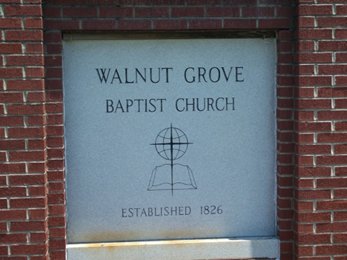
Names of the Members:
Samuel Hill, Nancy Hodges, Richard Gaines, Mary Youngblood, William Graham, Peggy
Henderson, Valentine Young, Dicey Sharp, Thompson Hodges, Jincy
Gaines, Benjamin Rosemond, Robert Gaines, Susanna Roseman, James Hodges, Francis Roseman, William
Hodges, Tabitha Hodges, Jane Huskerson
A newspaper article
written in 1943 described the history of the church as follows:
The "Church at the Walnut Grove on Mulberry
Creek" as it was always described by the clerk, did not show any gain in
membership by the end of its third year. Beginning with eighteen charter
members, it lost within two years two of these by letters of dismission and on
Oct. 20, 1828 Susannah Rosmond died, the first loss by death. This brought the
membership down to fifteen, but the addition of ‘Polly Hodges’, wife of James
Hodges by letter from Turkey Creek about this time, brought the membership up to
sixteen. Then on Jan. 4, 1830 after a sermon by the Rev. Nicholas Ware Hodges,
the first two members [were] received by baptism. These were ‘Polly Hodges,
sister of, and Mahala Hodges, the wife of Thompson Hodges.’ (This made the total
membership eighteen again.) Incidentally, there are three ‘Polly Hodges’ already
noted in the record.”
(Ref. Newspaper)
The ‘Nicholas
Ware Hodges’ mentioned in the article was the sixth child of Nancy and James. According to information from author
Margaret Watson, Nicholas Ware Hodges “was ordained in 1828 and organized several Baptist churches in upper South Carolina. He was on the committee for Furman
Academy which operated for two years in Edgefield under Baptist auspices, and he
was one of three men named by the State Baptist Convention to select a new site
for the school.” (Ref. 2548)
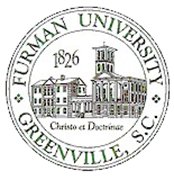
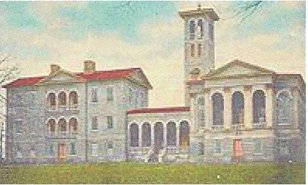
School seal
Furman Institute
Furman Institute, named for Richard Furman, was one of
the oldest colleges in South Carolina and the 64th oldest in the nation.
Nicholas was made head of Furman Institute in 1838, but he moved to Greenwood about
two years later and died there. In
1846, when Baptists established a boy’s school in Greenwood, it was named Hodges
Institute in honor of Nicholas. It
has since been torn down.
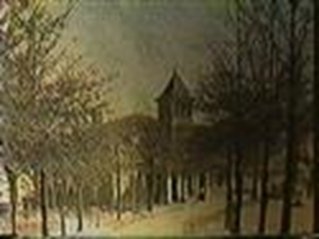
Hodges Institute, founded by the Baptists and named for the Reverend Nicholas
Ware Hodges, a minister in the area who was active in Baptist education.
A wonderful autobiography of Nicholas Ware
Hodges was kindly provided by Jimmy Rosamond.
It provides remarkable, priceless pieces of information about Nicholas
and all his family. The following
are some excerpts from the work:
AUTOBIOGRAPHY OF NICHOLAS WARE HODGES
“In the 44th year of my age, being confined at home by
protracted illness, from which it is very uncertain whether I may ever recover,
I proceed to the execution of a task, which I have desired and intended for many
years, viz: to write a brief narrative of my life, for the instruction and
benefit of my own children. . . . I
must first gratify a natural curiosity in giving some account of my parentage. My grandfather, Richard Hodges,
emigrated from Virginia, before the Revolutionary war, and settled in Abbeville
District, on Mulberry Creek, then a frontier settlement in the vicinity of the
Cherokee Indians. His wife's maiden
name was Jones. She survived her
husband many years. I can recollect
her when she was nearly a hundred years of age.
My father's name was James
[Hodges].
There being no school established in that
newly settled part of the country, and all that were capable being necessarily
employed in opening the country and reducing it under cultivation, my father had
no opportunity of going to school.
Three days were the most of his schooling.
The deficiency he lamented in [later] life and endeavored to supply it by his
own efforts. He learned to read and
sign his name.
Before the
Commencement of the Colonial dispute (Revolution) my grandfather died, leaving a
widow and twelve children . . . my grandmother was reduced to great suffering. The Indians burned her house and
carried one of her daughters away captive.
She returned home after the war, scarcely able to speak English. My grandmother had to fly for
protection to the woods and shelter herself and children in the hollow of a
large tree.” [This is the
account of Dorothy Hodges written about earlier.]
My father was about 18 years of age
at the commencement of the war and was soon engaged in active scenes. He was not the man that ever shrunk
from danger, where duty or necessity called, and was consequently employed by
his captain, with other daring young men, in several dangerous adventures
against the Tories. . . . In all
these battles, my father never received a single wound, though he never deserted
his post and saw many fall dead on his right hand and on his left. If this was not an evidence of a
special providence I know not where to find any.
After the return of peace, my father married Ann [Nancy Ware],
daughter of Nicholas Ware, who had
emigrated from Virginia and settled on Turkey Creek, Abbeville . . . . My mother's parents [Nicholas and
Peggy Ware] both dying, left under my
father's care their two youngest sons, Edward and Nathaniel A. Ware, at a tender
age. He brought then up as his own
children and gave them the best education which the schools in his reach
afforded. . . .” [For information on Nathaniel Ware, see his section.]
“I was born on Lord's day, 1st Jan 1797 and was the
sixth of eleven children. I was
delicate in appearance and thought not to be equal to the labors of the farm. My uncle selected me from the rest and begged my father to keep me at school until he himself should
finish his education, and he would then educate me, by way of return to my
father for the kindness he had shown to him.
My father did so. . . . One
trait of character early developed itself - that was fondness for reading; but
unfortunately I had no access to suitable books. . . . Having read all I could lay my hands
upon in my father's little library, I at length found an old book with very fine
and dim print. I resolved to know
its contents. It was the Bible. I
commenced at the beginning and read on with increasing interest. I often read by fire-light, after the
rest of the family had retired to rest, and thus early injured my eyes, from
which they never fully recovered.
Very salutary impressions were made on my mind at this age. I saw that God befriended those
patriarchs wherever they were and suffered none to hurt them. I had a great
desire to be like them. I was now
about 12 years of age. In the summer
of 1810, my uncle came to carry me to Abbeville, to commence the study of Latin
with him, whilst he was pursuing the study of law.” Nicholas further writes: “I must stop here to review the scenes
among which I had been brought up - together with their effect on my mind . . . my mother [Nancy Ware] had a great respect for religion, which
she had imbibed from her parents.
[Nicholas and Peggy Ware.]
They were both pious members of the Baptist church on Turkey Creek. She used to reprove her children
about using bad words and indulging passion.
My father was brought up in the Episcopal Church in Virginia, and
certainly had great respect for religion and ministers; but very little for the
church in which he had been brought up.
He often read the Testament and other good books, but said nothing to his
children about doing so. The
Testament, however, was generally used as a school book . . . . I hated Latin because I was to be
made proud by learning and could not become the humble Christian I had desired
since I first read the scriptures, and gave way to grief and melancholy. After some months my uncle entered me
as a student, at Old Cambridge and engaged boarding for me with Mr. Thomas
Chiles.”
Nicholas continued, “After a short stay at my
beloved home, I was carried back to Cambridge, in the beginning of the year
1811. My uncle having made his
arrangements to move to Natchez, Miss., paid me a short visit. He gave me good advice which made an
impression upon me. This was the
last time that I ever had the pleasure of seeing that dear uncle to whom as an
instrument I am indebted for what education I have. I became deeply interested and
prosecuted the study of Latin, Greek and higher English, and succeeded in taking
the prize offered our class. I
remained until the close of the year, 1812.
I spent the year 1813 in reviewing, reading, and instructing my younger
brother and sisters. During the present year, l8l3, my religious impressions
increased. I began to discover my
depravity more and more, and was often in much distress. I made many resolutions, but was
unable to keep them, which destroyed my peace of mind. But, as yet, I knew not the way of
salvation.
In the year, 1814, being about 17 years of
age, I taught a school at Turkey Creek Church and boarded with my Uncle Edmond
Ware, at Scuffletown. I returned to
Cambridge in 1815.
[. . . .]
During the following vacation I occupied a student's cabin alone. Here, happy in my seclusion, I had
much time for meditation and prayer.
I began to reflect seriously upon my situation as a sinner. I had been long striving to obtain
religion, but found myself further off, instead of approaching nearer my object.
[. . . .]
I thought myself the chief of sinners and
was at my wits end. I could make no
greater exertion than I had already made, which had proved abortive. Thus the
lord was stripping me of my self-righteousness; for I had been, for years,
trying to work myself into His favor.”
In closing, Nicholas relayed how, “one Sunday morning I was sitting in my cabin, reading . . . about a man who was in the habit of
cock fighting. Having lost a bet, he
took a solemn oath not to be engaged in such sport. . . . He was, at length, tempted himself .
. . but was struck dead in an instant.
When I read this I closed the book and thought I was as guilty as that
man, for violating so many solemn resolutions.
I looked for the hand of God to be let loose and cut me down. I rushed out of the cabin and sought
the woods. Falling upon my knees I
cried to God for mercy. Tears gushed
from my eyes which afforded some temporary relief. I returned slowly to the cabin with
despair seated at my heart. . . . I
concluded to read again the Epistle of Paul to the Romans. . . . When I came to the 10th chapter, new
views began to be presented. I read,
‘Christ is the end of the law for righteousness to everyone that believeth . . .
the word of faith, which we preach: that if thou shalt confess with thy mouth
the lord Jesus, and shalt believe in thine heart that God raised him from the
dead, thou shalt be saved.’ These
remarkable words arrested my attention.
I thought ‘Is it possible that salvation is placed on such easy terms
merely to believe?’ I had been all
the while under the impression that I must reform and do something to gain the
divine favor. Here was a new
doctrine to me, and I felt ready to lay hold upon it, for every other refuge had
proved a failure. I then asked
myself, ‘Do you believe in the lord Jesus?’
I answered ‘I most certainly do’.
I then began to feel some degree of joy from the thought that there was a
bare possibility for such a sinner as myself to be saved. This joy gradually increased until I
left my cabin to walk in the open fields.
Here as I looked around, all nature seemed to put on a new and more
lovely aspect.”
[You can find the autobiography in its entirety on the web.]
Nicholas was so inspired that he spent the rest of his life preaching the gospel. He married twice. His first wife was Elizabeth (Eliza)
Hughes of Edgefield.

Record
They had two sons, Charles and Edward.
There were more children by his second wife whose name is not known. Nicholas died of tuberculosis at the
age of 44 on October 7, 1841. His
mother, Nancy Ware Hodges, would outlive him by 15 years; dying in 1856
at the age of 89. Nancy’s husband
had also predeceased her in 1828.
“James’ wife, Nancy Ware Hodges, as
his widow, applied for his pension
#W7776. Charlie Hodges sent an
affidavit to support the pension request, March 20, 1846, in which he stated
that James was his brother.”
(Ref. Pension Records)
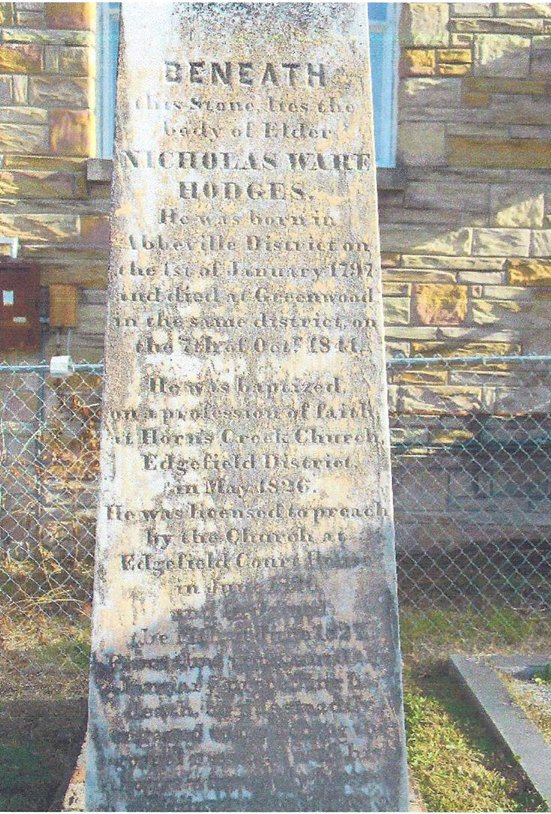
Grave for Rev. Nicholas Ware Hodges
(4)
William -
In the winter of 1768,
Nicholas and Peggy were expecting another child. Their firstborn,
James, had passed away three years earlier,
and little Nancy had just turned one. October came and went. Finally, on November 1st,
the parents and grandparents (James and Agnes)
welcomed another Ware boy into the world, William
T. Ware. In all likelihood, the letter ‘T’
stood for Grandma Agnes’ maiden name of Todd.
It was a busy year on all fronts.
By 1768, the colonists were feeling the pinch of Great Britain.
Samuel Adams had
circulated a letter opposing the Townshend Acts, a series of laws meant to raise
revenue in the colonies for British benefit.
It was also England’s way of flexing her muscles so it would be known
that she had the right of taxation over her subjects. The action only caused more tension
in the colonies and with English troops (under General Gauge) landing in Boston,
relations were only destined to deteriorate.
Since the war did not come to a complete close until
1768, it makes sense that 15-year old William
would want to be a part of the action.
His entire youth had been spent listening to his family and all colonists
chafing at British rule. Data
compiled by Reverend E. M. Sharp gives proof of his service:
see below
“Available records follow on four of the children of the pioneer Nicholas Ware.
William Ware . . .
a teen-aged soldier in the Revolution, married
Mary Agnew.”
Further
evidence can also be found in
The National Society of the Daughters of the
American Revolution Volume 72 where it states,
“William Ware (1768-1856) is buried in
Pontotoc County, Miss., where his tombstone bears the inscription, ‘A soldier in the Revolution.’ He was
born in Abbeville District, S. C.”
William married
Mary Agnew in 1793 in Abbeville County, and they had the following children:
Marriage record

1. Martha (Patsey) Ware married Charles
Fooshe. She passed away in 1852.
2. Thomas Ware
3. Nicholas Mattison Ware (born May 5, 1794) married
Elizabeth (Betty) F. Dial in 1825.
They had a son named William.
Nicholas died in January 1851.
4. Malinda E. Ware married James M. Vandiver.

Marriage record
5.
Martha Ware -
6. James Agnew Ware (born May 12, 1804) married
Harriet Pulliam on August 13, 1828. (For more details of his life, see section marked
 below.)
James died April 11, 1865, and is buried in Ware Cemetery, Pontotoc,
Mississippi. below.)
James died April 11, 1865, and is buried in Ware Cemetery, Pontotoc,
Mississippi.

Marriage record
7. Nathaniel Ware -
8. Edmund Ware
-
9. Nancy Ware -
10. Emma Eliza Ware (born in 1813) married
James Franklin Killingsworth in 1887.
She died in 1889.

Marriage record
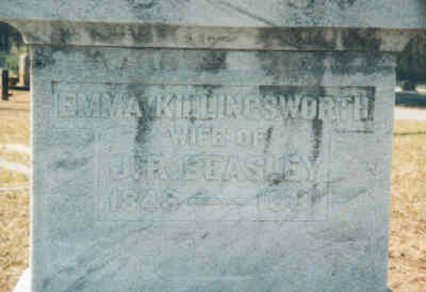
Grave of Emma Eliza Ware Killingsworth
Nicholas’s
grandson by William, Dr. James Agnew Ware, led an interesting life. Born in 1804, he married Harriet
Pulliam on August 13, 1828. The
couple had the following children:
Priscilla “Priss” Ware (1835); Mariah Ann Hazeltine “Hass” Ware (1836), who
married Sam Weatherall; Mary Agnew Ware (1839), who married James Wilde Crocker
in 1857; William Ware (1841), who died as infant; Margaret Ware (1843); and
Harriet “Hattie” Ware (1871), who wed Sylvanus Lattimore Hearne in 1871.
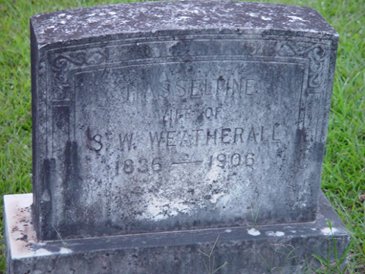
Grave of Hazeltine Ware
According
to the History and Genealogy of the Hearne Family, S.L. Hearn
“was married in 1871 to Miss Hattie, daughter of Rev. Dr. James A. Ware, a South Carolinian by
birth, who came to Pontotoc county, Miss. at an early day, where he became a
prominent physician and Baptist minister, and one of the county's best citizens.
He and his wife both died there.”
James was not only a doctor, but a dedicated minister as well.
According to Hometown Mississippi, “Toxish Baptist Church was established in
1837 by Rev. James A. Ware of South Carolina.” One of his descendants, Mark
Weatherall, wrote, “Dr. Ware, my maternal
grandfather, was a Baptist minister and was pastor of the Toxish church for
thirty years.”
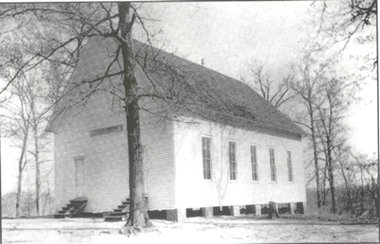
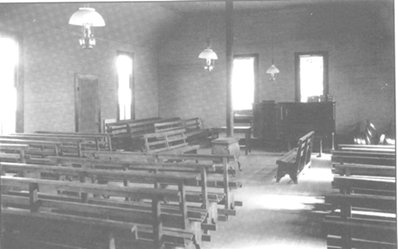
Photos courtesy Mississippi Department of Archives and History
-
Toxish Baptist Church
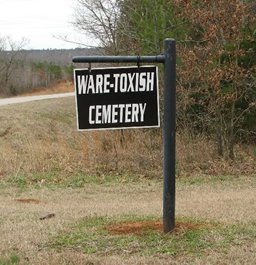
Sign for cemetery
In a recent book titled
The Family Saga: A Collection of Texas Family Legends by Francis Edward
Abernethy, one of James’ descendants submitted a family story of what happened
to Reverend Ware during the Civil War.
Below is an excerpt from the writing of Gloria Counts:
“Acting on a rumor from an escaped slave,
the Yankees demanded to know where Dr. Ware had buried his gold. [He] replied that there was no gold . . .
the Yankees did not believe this.
They took him from the house and hanged
him by the neck several times, up and down, trying to make him tell where he
buried his money. When their torture
proved fruitless, the soldiers finally rode off after taking Dr. Ware’s boots
from his feet and leaving him lying in the snow.
He was never well again, and he died soon after in April 1865.”
(Ref. 2538)
For the full story, see
The Family Saga: A Collection of Texas Family Legends.
William lived a long and prosperous life in South Carolina, expanding his talents to mill work.
“Ware Shoals is the site of an old water
wheel grist mill operated in the early 19th century by William Ware at Rutledge
Ford, on the Saluda River.”
(Wikipedia)
Like many of his
generation, he used slave labor to manage his large holdings, and according to a
newspaper article printed in 1846, he owned the following 15 slaves:
“Henry, Briss, Fort, Jim, Milly, Nelly,
Ethick, Edmond, Dosh, Mary, Tena, Dicey, Mitchell, Kigh, Wesley. . .”
(Ref. The Banner, Abbeville)
We have recently been able to learn more about
William
Ware through the records of another ancestor, Peggy Smith Kittell. She kindly offered the chart below to
show the family line she follows, coming down from Nicholas’s son – starting
with William.
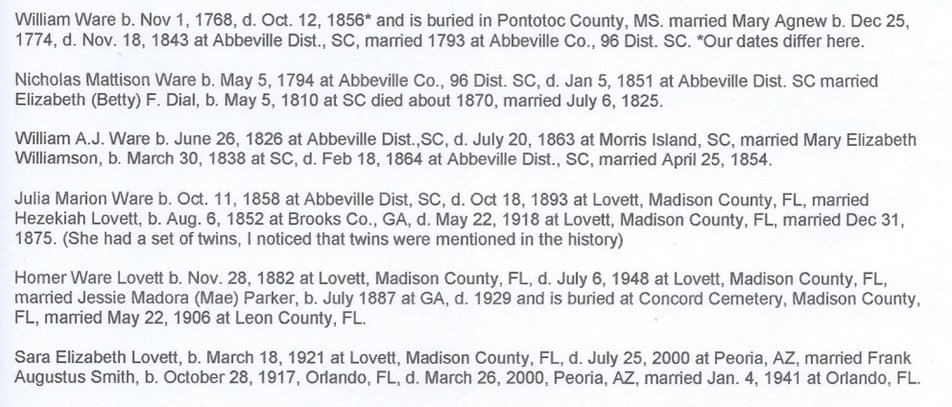
Lineage from Peggy Smith Kittell
(Ref. 2337)
William’s wife, Mary Agnew Ware, had been
born on Christmas Day in 1774, and she died before William on November 18, 1843. She was 69 years old at her death and
was buried in Turkey Creek Baptist Church Cemetery. William,
who was visiting his son, James Agnew Ware, in Mississippi when he died, was
sadly not able to be buried beside her.
Upon his death on January 12, 1856, at age 88, he was laid to rest in
Pontotoc County, Mississippi.
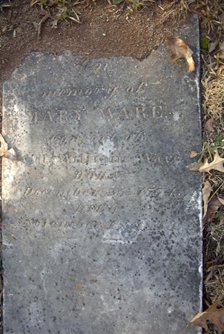
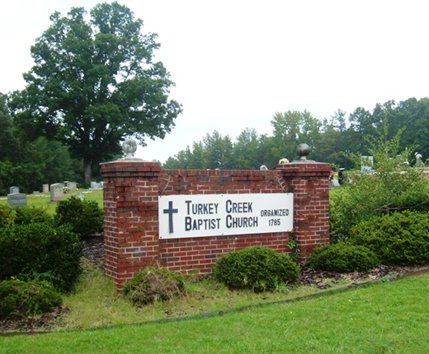
Grave
for Mary Agnew Ware (wife of William) who was buried in Turkey Creek Baptist
Church Cemetery
(5)
Thomas - Nicholas
and Peggy added another son to the family in
1770, naming him
Thomas Ware. He would marry twice. The two wives were Sarah Gaines and
Nancy Johnson, but there is conflicting data on which one he married first. Most references say that Sarah died
in 1840 and Nancy lived until 1870.
The known children of Thomas are:
Mary Catherine Ware
– born 1810 “She married John Richard Stephens, Jr.
and they had nine children. In 1844,
both John and Mary died in the typhoid epidemic that was raging at the time. John’s parents, John Sr. and Sarah,
left South Carolina where they were living at the time and went to Pontotoc
County, Mississippi to assist in the rearing of the eight orphaned children of
John Richard Stephens Jr. He and his
wife, Mary Ware, a small daughter named Sarah, and a slave had died within a
period of three weeks during a typhoid epidemic.
They were the first persons buried in Cherry Creek
Baptist church
cemetery.”
(Ref.
Stirpes – A Stephens Summary by: Shirley Stephens Martin, September 1996)
The children of John and Mary Catherine Ware Stephens were:
Enoch Monroe Stephens
(1828
– 1899) who wed Mary F. Reeder.
George Washington Stephens
(1829 - 1922) wed Theresa Smith, who died in 1883, and Roenna J.Holditch, who
died in 1940.

George Washington Stephens – grandson of Thomas Ware and great grandson of
Nicholas Ware
Penelope J. (Nelly) Stephens – (1831- 1913) wed Hudson Posey Berry.
John Anderson Stephens - (1833 - 1879) wed Sarah (Sallie) Hitt Ball.
Robert Madison (Matt) Stephens – (1834 - 1888) wed Rachael Elliott Smith.
Mary C. Stephens (1836-1905) wed James “Buff” Smith and James R.
McCarver.
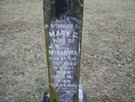
Mary
McCarver – granddaughter of Thomas Ware and great granddaughter of Nicholas
Nancy (Nonnie) A. Stephens
– (1847 - 1925) wed Miles Pegues.
Margaretta Stephens (born unknown date)
William Henry Ware
– born 1820
Perdy (Peregrine)Ware – born 1822
Thomas Jefferson Ware
born 1826
“Thomas
Jefferson Ware, son of Thomas Ware of Abbeville County, S.C. born in Laurens
Co., S.C. 1823 m Frances Malinda Murff 11/14/1852. He migrated to Monroe Co., Miss.
1859, joined the Confederate Army, was captured and died in U.S. Army Prison
Camp at Memphis, Tenn.” (Ref.
Web)
JA Ware born 1832
GN Ware
born 1836
Thomas
Ware lived 83 years and died February 28, 1853.
(Ref. 818)
(6)
Elizabeth - It
was a few years before Nicholas and Peggy had
another baby, but according to church records, they had a little girl named
Elizabeth
(called Bettey or Betsey) on March 22, 1774.
“BETTEY
WARE DAUGHTER OF NICL. WARE
AND MARTHA, HIS WIFE
WAS BORN MARCH 22ND 1774”
Church Minutes
AUG. 12, 1773 THE FOLLOWING INFANTS WAS RECEIVED
INTO THE CARE OF THE CHURCH/
CHLOE SMITH DAUGHTER OF CALEB SMITH...
BETTEY WARE DAUGHTER OF NICL. WARE AND MARTHA/
HIS WIFE WAS BORN MARCH 22ND 1774
(Ref. LIBBIE GRIFFIN TO GLENN GOHR) Broad Run Church minutes
Elizabeth came into a world on the brink of revolution,
and her birth year would mark the convening of the First Continental Congress. (This convention of delegates from
the 13 colonies met to discuss actions that needed to be taken in response to
England’s continued tyranny.) The
Wares could have no way of knowing at this celebration of Elizabeth’s birth that
her father would soon be fighting in a war.
On August
11, 1794, at the age of 20,
Elizabeth
married John Henry Madison. [In the
1700s the name was spelled ‘Mattison’ - it was only later that it was changed to
‘Madison.’] Henry, as he was
known, was the son of Thomas Mattison who came to Carolina from Virginia about
1795, settling in the Pendleton District.
Elizabeth and Henry had four children:
Fielden (born September 9, 1795); Strother (born June 1797); Mahulda
(born July 3, 1799); and Leroy Ware (born in 1802).
Of these children, we know Fielden died very young. The information about his brother,
Strother, has come through one of his descendants.
(See below)
“I now have good evidence that Strother Madison was indeed the
son of Henry (perhaps John Henry) Mattison and Elizabeth Ware who married on 11
August 1794.
Also that Henry was the son of a Thomas Mattison who made
his will in Abbeville Dist. SC on 12 Jan. 1821 with the estate finally being
settled in 1834 after the death of his unnamed wife.
His children listed in the settlement are:
Nevil; Thomas, Jr.; Francis; Jesse; Betsey Mattison
Calvert; Jane Mattison Young; Thomas Davis, Jr. in right of his deceased mother,
Drucilla Mattison Davis; and Henry Mattison's widow,
Elizabeth Mattison, nee Ware.
Henry Mattison pre-deceased his father.
Administration of his estate was given to Elizabeth
Mattison, Thomas Mattison, Sr. (father of Henry) and
Wm. Ware on 29 Oct. 1804
and Elizabeth's brother, Wm. Ware was named
guardian of her three
living children, Strother, Leroy Ware and Mahulda. An older son,
Fielden, born 9 Sept. 1795 is said to have died young.”
(Ref. Ancestry) (Underling done by me)
Strother
married twice. When his first wife,
Elizabeth, died, he remarried in 1824 to Catherine Sample. By the time of his second marriage,
he was 27.
Marriage record for Strother
Madison, Strother Sample, Catherine 13 Jan 1824 Marengo
According
to Ancestry.com, Strother Madison (notice the change in spelling of the last
name), was “born in South Carolina in
1797, married Catherine Sample and they had 10 children. He passed away on 26 Sep 1885 in
Noxubee, Mississippi, USA.” It
is believed that Strother was traveling to Texas with some of his children when
he died. Although there is no
visible gravestone for him at this time, there are cemetery records that show he
was buried in Noxubee County, Mississippi, on September 26, 1885.
Some of the children of
Strother and Catherine Sample Madison were:
(1) Leroy Ware Madison (1818-1903) from his first marriage; (2) Susan
Madison (1828); (3) William Gaines Madison (1830); (4) James Strother Madison
(1833), who wed Rebecca Barley; (5) Nathaniel Ware Madison (1835), who wed
Cornelia Hawkins on September 24, 1856; (6) Mahulda (Hilda) Madison (1839); (7)
Alexander Madison, and possibly others.
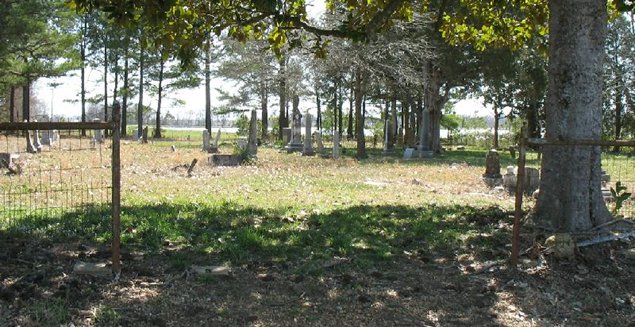
Cemetery for Strother Madison -
Son of John Henry
Madison and Elizabeth "Betsy" Ware of Virginia.
Strother Madison was the husband of Catherine Sample. They lived in
Marengo, Alabama. It is believed that he
was on his way to Texas with some of his children.
We don’t have much information on Elizabeth and Henry’s son, Leroy Ware Madison
(born 1802), but his older brother, Strother, clearly named his first son after
him. Leroy Ware Madison, born on
August 18, 1818, married Frances Deliah Jane Tucker and, according to
Ancestry.com, they had 10 children.
He passed away on December 23, 1903, at the age of 85.
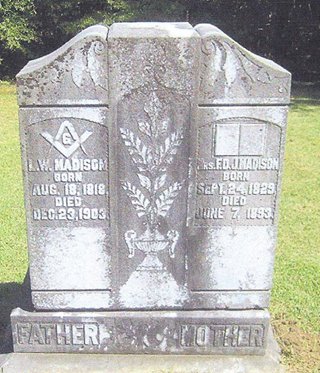
Grave
for Leroy Ware Madison
The only daughter for
Elizabeth and her husband, Henry, was Mahulda
Malinda Madison, who was born on July 3, 1799.
She married Joseph Sample, and the couple lived in Alabama for some time. They had two sons, Henry Alexander
Sample and Leroy Ware Sample. The
couple later moved to Texas where Mahulda died.
She was buried on March 1, 1889, in Marcelina Baptist Church Cemetery.
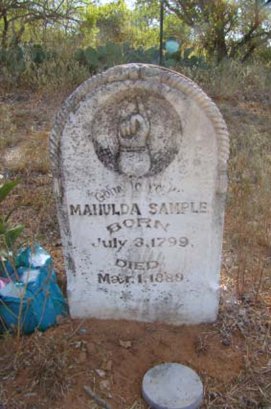
Mahulda Malinda Madison Sample –
daughter
of Elizabeth Ware Madison
On January 17, 1806,
Elizabeth Ware remarried. Her
second husband, Benjamin Pendleton Gaines, was the son of James Gaines and
Mildred Bland Pollard. According to
one of his descendants, “My grandfather
was Dr. Benjamin Pendleton Gaines - he moved from Virginia to Abbeville Dist
South Carolina and married a Widow, Mrs. Elizabeth Madison, formerly a Miss Ware
. . . . My grandparents had two
sons, Edmund Pollard Gaines who married Susan Sample, and my father, William
Baxter Pendleton Gaines, born 12 Sept 1808.
Dr. Benjamin Pendleton Gaines was a surgeon in the War of 1812.”
Another descendant, Wynell Madison Patton, kindly provides further information: “I'm interested in Benjamin Pendleton Gaines,
born in Virginia. A doctor and
surgeon; he was in the War of 1812 and died at Salisbury NC in 1814. He married Elizabeth Ware Mattison in
1806 in SC, after the death of her first husband Henry Mattison. She had 3 children by Henry Mattison: Strother, Leroy, and Mahulda. Strother Madison is my 3x great
grandfather. She had 2 sons with
Benjamin: Edmund P. and Wm. Baxter
Pendleton Gaines. Strother married
Catherine, a daughter of John Sample. Edmund married Susan, a second daughter of
John Sample. Mahulda married Joseph, a son of John Sample. They lived in Alabama for a while. After the deaths of Catherine,
Edmund, and Joseph; they ended up in Texas.
The other half brother, WBP Gaines; arrived in Texas about 1834 and
fought in the Texas Revolution against Mexico.
He was a lawyer, plantation owner, and legislator in Texas.”
Benjamin was
a physician and surgeon who served in that capacity
during the War of 1812 with the 6th Regiment (Coleman's) Virginia Militia.
He died while in service at Salisbury, North Carolina, in 1814. Elizabeth was a widow again at the age of 40 and
never remarried.
We know the following information about the children of
Elizabeth and Benjamin Gaines:
Edmund Pollard
Gaines (1807-1850) wed Susan N.
Sample in 1828 in Marengo County, Alabama.
They had seven children: (1) William P. Gaines (1830); (2)
Mahulda Gaines (1832); (3) John N. Gaines (1834); (4) Strother Gaines (1835);
(5) Abner Pollard Gaines (1836); (6) Catherine Gaines (1837); and (7) Edmund
Gaines (1842).
By 1860, Susan and some of her children had moved
to Evergreen, Burleson County, Texas, where her brother-in-law William Gaines
had settled.
Susan died in March 1870 in Texas.
William
Baxter Pendleton Gaines
(September 17, 1808 - May 19, 1891)
In an article written by Stephanie
P. Niemeyer for “The Handbook of Texas” we learn much more about William Gaines.
“William Baxter Pendleton Gaines, planter and legislator, was
born on September 17, 1808, in Abbeville, South Carolina, son of Benjamin P. and
Elizabeth (Ware) Gaines.
He taught school in Marengo County, Alabama, until
1832 when he became a merchant in Demopolis, Alabama.
He was approached to enter into a business arrangement in
Texas, and
[in]1835, he established himself in Nacogdoches. By October 1835
Gaines was a wealthy man.
He contributed money to the Texas Revolution and
served as an officer in the volunteer force from Nacogdoches under Gen. Thomas
Rusk that marched to reinforce the siege of Bexar. Gaines acted as
a commissary and quartermaster. After the army
reorganized, Gaines returned to Nacogdoches to serve as deputy paymaster general
of the Texas Army.
[He] left the army to
pursue other opportunities and lived in Galveston while studying law under John B. Jones.
He was admitted to the bar in 1840. In 1842 he moved to Brazoria County with a large number of
slaves and began a cotton and sugar plantation. By 1860 Gaines
had 47 slaves working on his plantation.
In 1846 he joined the United
States Army to fight the Mexican War. He fought with distinction during the
battle of Monterey and was awarded a sword for gallantry.
In 1850 Gaines married Eugenia Gratia Harris of Charlotte,
North Carolina.
They had five children.”
The
Handbook of Texas Online - Article by Stephanie P. Niemeyer
(7) Edmund Pendleton
- On Aug. 16,
1780, Nicholas and Peggy Ware had another
baby boy, Edmund P. Ware. Big sister,
Nancy, was now 13 and baby sister,
Elizabeth,
had just recently turned six. A lot
had happened in the colonies since the birth of Elizabeth. Thomas Jefferson had written the
Declaration of Independence, the 13 colonies had united in their cause for
freedom, an army had been formed under the leadership of General George
Washington, and the French, in 1778, finally declared war against Britain,
making a much needed alliance with the revolutionary forces.
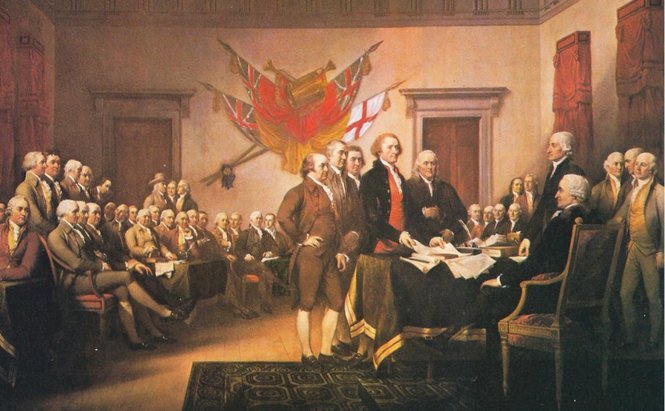
Signing of the Declaration of Independence
It is likely that Peggy saw little of
Nicholas during those years, as he was off fighting in the war. We know
from records kept faithfully by the
Daughters of the American Revolution (DAR) that Nicholas was in the Continental Army in South
Carolina. He eventually attained the
rank of colonel.
DAR Military record

The war would not officially be over until 1783, but Nicholas obviously made it home for a visit
sometime earlier because Peggy was soon pregnant again. One can only imagine the concern that
engulfed her during this time, and what a celebration they must have had when
Edmund
Ware was born and the war ended.
Their happiness did not last long, however. Young Edmund’s childhood was cut short with the death of
both of his parents a few years after his birth.
An orphan at the age of seven, he and his younger brother were raised by
their older sister, Nancy, and her husband,
James Hodges. As Nancy’s son,
Reverend Nicholas Ware Hodges, wrote in his autobiography,
“My mother's parents both dying, left under
my father's care their two youngest sons, Edward and Nathaniel A. Ware, at a
tender age. He brought then up as
his own children and gave them the best education which the schools in his reach
afforded.”
(The author confused spelling of Edmund
with Edward.)
Edmund married twice. We know little about his
first wife, Theodocia Nash, because she died shortly into the marriage. We can ascertain from Edmund’s will
that the only child born of this union was Albert N. Ware. In a piece called From Hill To
Dale to Hollow, Ware Shoals, South Carolina, published by a town appointed committee in 1983, we learn “General
Edmund Ware, son of Nicholas and Martha Hodges Ware, married a second wife,
Margaret Gaines, daughter of Thomas Gaines of Newberry County.”
When Edmund remarried, his new wife became a stepmother to Albert, and the
couple added even more to the family.
All in
all, the Edmund Ware family had the following eight children:
(1) Albert Nicholas Ware – born prior to
Edmund’s 2nd marriage
(2) Thomas Edwin Ware – born 1806 (Details of him following)
(3) Nimrod Washington Ware – born 1810. He married Catherine Norwood
and they had six
children. Nimrod died in 1840 in
Louisiana.
(4) Emily Ware – born 1812 and married James
S. Rogers
(5) Peregrine (Perry) Gaines Ware – born 1814
married Caroline Broodway
(6) James Henry Ware – born May 25, 1815,
married Margaret C.L. Isabella
Johnson
(See obituary below)
(7) Louisa Catherine Ware – born December 3,
1818 and married Thaddeus
Choice Bolling. Lousia died
October 15, 1910
(8) Edmund Pollard Ware Jr. – born 1821
The names of
these children are also validated in Edmund’s will, written in 1833. (See below)
Edmund Ware (17 Apr 1833 Abbeville SC Will Book 2-315)
(Abbeville County South Carolina Will Book 2-315)
EDMUND WARE, 17 Apr 1833
"To be buried at Turkey Creek Church where
some of my children are buried"
Son by first marriage: Albert N. Ware.
Son-in-law: James S. Rogers, Thomas Edwin Ware, Peregine P. Ware, Edmund P.
Ware.
Son: Nimrod Washington Ware, James Henry Ware.
Dau: Louisa Catherine Ware, Emily Rogers.
Wife: Peggy.
Wit: Wm. Ware, J. H. Baskin, Thomas P. Spierin
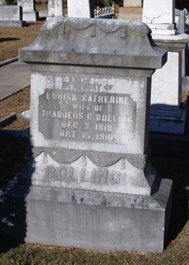
Grave for Louisa Catherine Ware Bolling
The following is the obituary for
Dr. James H. Ware – son of Edmund Ware:
Distinguished Physician Passes Away
at the Ripe Age of Ninety-two years
“Greenville, April 24 – Dr. James H. Ware, one of the oldest
and best known citizens of this city, died at the home of his sister, Mrs. M.L.
Donaldson, this morning at 4 o’clock. Dr. Ware had
been a citizen of Greenville for about 15 years and formerly practiced medicine
in Laurens, Abbeville, and Greenville counties. He was a member
of the secession general assembly, to which he was elected in 18—from Laurens
County.
He was a man of great attainments and a member of the well
known Ware family, being a son of Gen. Edmund E. Ware, who was well known in the
public life of the state a half century ago. He is the
grandfather of Dr. J. R. Ware of this city and is survived by a number of
members of his family in this city and other points.
He would have been 92 years old had he lived until the 26th of this month, and his
practice as a physician covered over 40 years.
There has been much written about the
oldest son of Edmund
and Peggy,
 Thomas Edwin Ware.
He not only attained recognition for being a highly successful plantation
owner, and a politician for the state of South Carolina, but also for being the
focal point of a murder trial that occurred in 1853. Thomas married Mary William Jones,
the only daughter of Adam Jones and Jane Williams. Adam “moved to Greenville County where he
built his residence. It is the dominant residence at a crossroads community
known as Ware Place.”
(Ref. 2546) Thomas Edwin Ware.
He not only attained recognition for being a highly successful plantation
owner, and a politician for the state of South Carolina, but also for being the
focal point of a murder trial that occurred in 1853. Thomas married Mary William Jones,
the only daughter of Adam Jones and Jane Williams. Adam “moved to Greenville County where he
built his residence. It is the dominant residence at a crossroads community
known as Ware Place.”
(Ref. 2546)
Marriage record
"Marriage and Death Notices from Pendleton SC Messenger 1807-1851".
Compiled by Brent H. Holcomb
Issue of July 2, 1834 pg. 45.
Married on Thursday, the 19th inst., by the Rev. Sandford Vandiver,
Mr. Thomas E. Ware, of Abbeville District to Miss Mary Jones, only daughter of
Capt. Adam Jones, of Greenville Dist.
According
to information housed in the ‘Special
Collections and Archives’ at James B. Duke Library in the Furman Institute, “Thomas Edwin Ware (1806-1873) was born to General Edmund Ware and Margaret “Peggy”
Gaines. He was a prominent planter
of Greenville District, and his papers represent an important source for local
and state history. Ware owned and operated Ware Place plantation and mill in the
southern part of Greenville District and employed 102 slaves on his land in
1860. Ware represented Greenville in
the SC House of Representatives during the following terms: 1840-41, 1844-45,
and 1846-47. Then he served in the
state Senate for five additional terms: 1848-49, 1850-51, 1860-61,
1862-63, and 1864. He married Mary Williams Jones,
daughter of Adam Jones (builder of Ware Place).
Thomas was, indeed,
successful. According to a book
titled Greenville: the History of the City and County by Archie Vernon
Huff in 1995, “The Wares moved to the Greenville District and lived with
Jones on his plantation, later known as
Ware Place . . . . He and his
wife joined Brushy Creek Baptist Church
in 1854 after he had a moving religious experience.”
Thomas
was the largest slave
holder in the Greenville district and was considered a
“prominent politician and military man for
the state of South Carolina.”
(Ref. 2546)
Thomas owned about 700
acres of good land on the Saluda River, but a large part of his wealth came not
from farming but from hiring out the vast number of slaves he owned (102
according to the 1860 census). His
plantation, called Ware Place, was known for its beauty throughout the area of
Greenville.
The following
photographs are graciously offered by Bob and Norma Ware who visited the lovely
home. All of the helpful notations
accompanying the photos are also provided by Bob Ware.
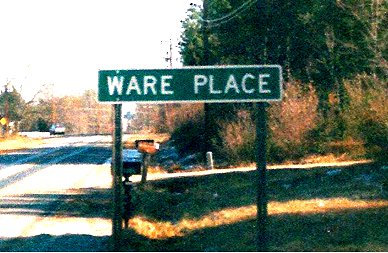
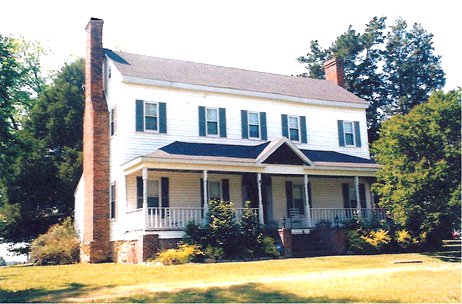
Sign for Ware Place
Ware Place
“Ware Place is located about 17 miles from the center of Greenville at the
intersection of US 25 and SR8. It is
not a town, nor is it a community or a village; it is simply four corners of the
intersection. A gas station is
located on one corner, a couple of antique stores on the corner across from it. The Ware Plantation residence is
across US 25 from the stores and a Greenville County fire station on the
remaining corner. Other than that,
the area is typical rural.”
Ware Place – home of Thomas Edwin Ware
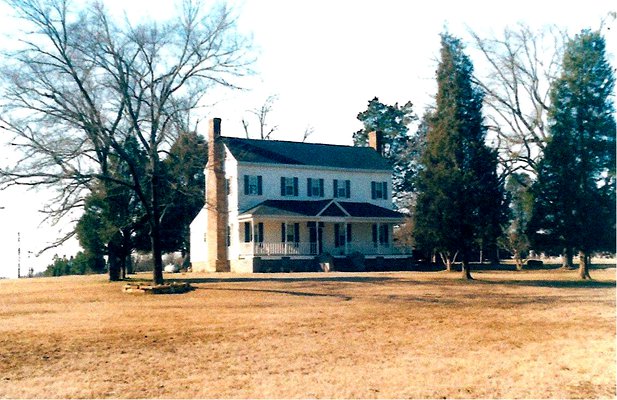
“The main view of
the house as seen from US 25”
I am deeply indebted to
Bob and Norma Ware for sharing their photographs, knowledge, and experiences
with me for this book.
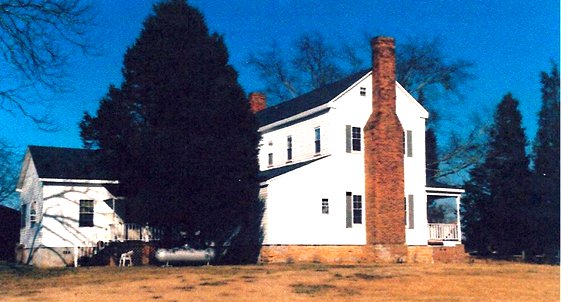
“A view of the south side of the house with a partial view of the replacement
kitchen”
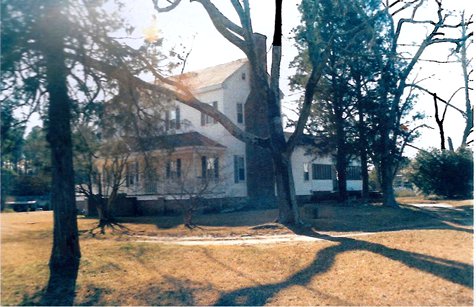
“A view of the north side of the house taken from SR 8”
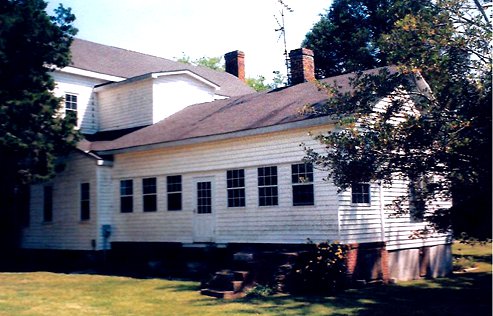
“The north side of the new kitchen”
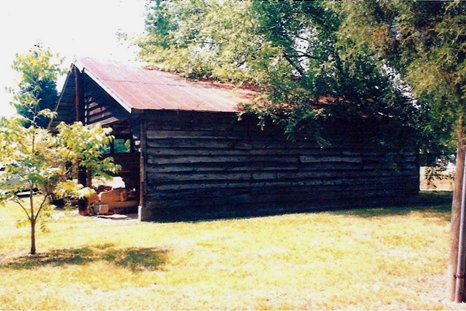
“The old kitchen that has been moved from the rear of the house to the north
side and is now used as a garage and utility shed”
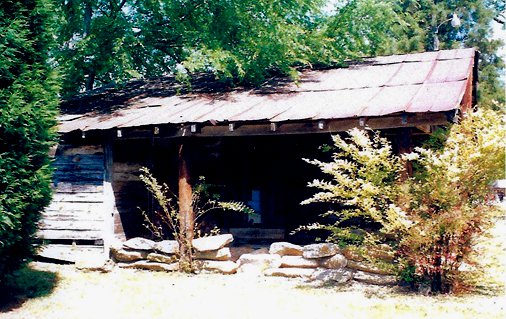
“View showing the conversion of the old kitchen to the garage”
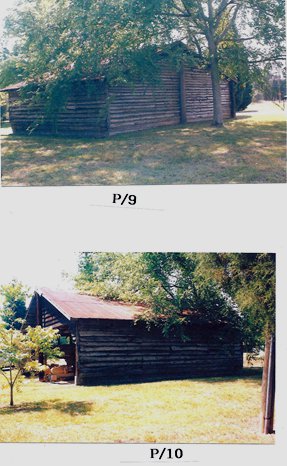
“Side view and rear view of the old kitchen.
It appears that it was a large structure in its self.”
From the
beginning of their marriage, Thomas and Mary resided in the same house with her
parents. Mary was an only child and
obviously close to her mother. It
would seem that relations with her father were often difficult, however. It was later reported that
“Col. Ware lived in the greatest harmony
with [him], and never had any difficulty with him, though he did not approve of [his] conduct towards his family.”
(Ref. 2556)
The situation only became more stressful after Mary’s mother died, and
“Col. Ware was ever a peace maker between
[Mary’s father] and his wife.”
(Ref. 2556)
In 1853, the situation
escalated to a horrible level.
Thomas and Mary decided to leave the plantation and move into Greenville to
avoid further problems with her father, who was now drinking more and more. On the day of their departure, there
was a major confrontation. An
intoxicated Captain Jones attacked Thomas in a fit of rage with a pair of iron
fire tongs. Thomas ended up pulling
out a gun he owned and fatally killing his father-in-law. He was arrested for manslaughter.
An excerpt of the trial of Thomas Edwin Ware, taken from a newspaper titled The Southern
Patriot in Greenville, South Carolina (printed on Thursday morning April 21,
1853), gives vivid details of the many testimonies brought forth. The physician who examined both men
after the shooting gave the following quote in an effort to show that Thomas had
acted in self-defense.
“The blow was aimed, as he thinks, at Ware’s head:
Ware’s arm, one of the bones broken;
[doctor] thinks if the whole force of the blow
had been received on his head, it would have produced fracture of the skull and
most likely death as a consequence; had attended Ware’s arm; paralysis of the
fingers; nerves injured; may never recover use of the fingers . . . .”
(Ref. 2556)
In a somewhat shocking
turn of events, Thomas was convicted on the charge of manslaughter but given an
incredibly light sentence. In fact,
he received a full pardon one week later.
The following article, written about this interesting story, has been
graciously and generously offered by the author, Norma Ware.
WARE PLACE
by Norma Ware, English 9, Writing Memoir,
Autobiography, and Family History, April 15, 1997
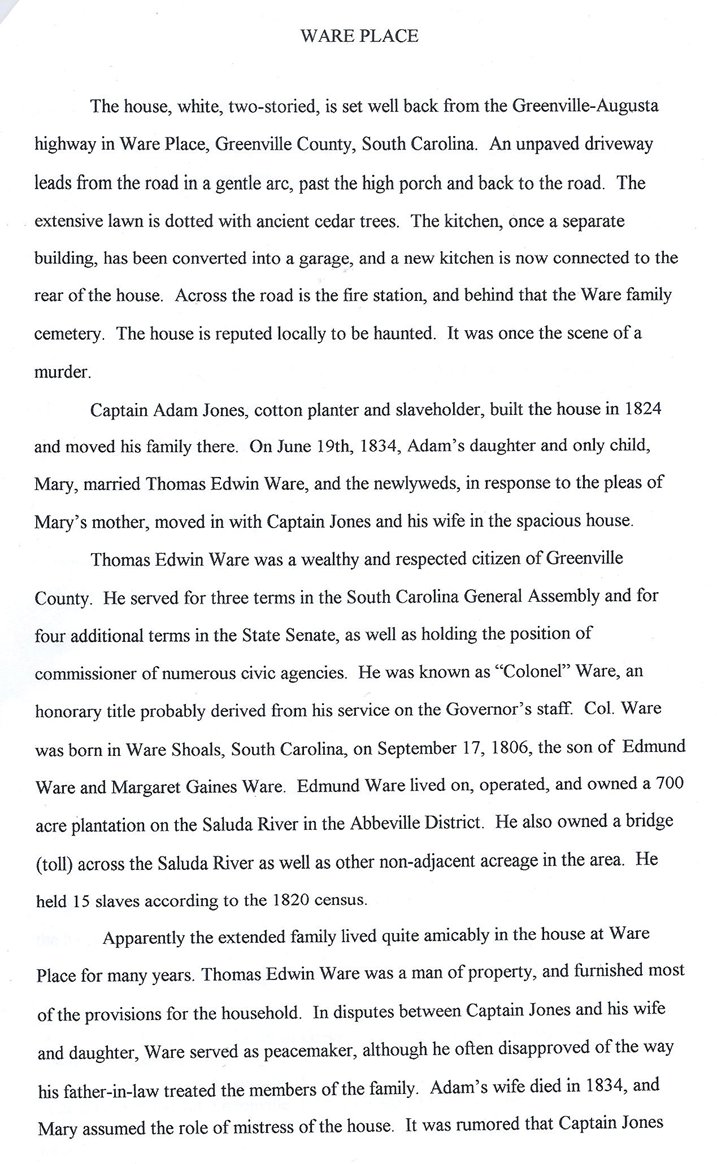
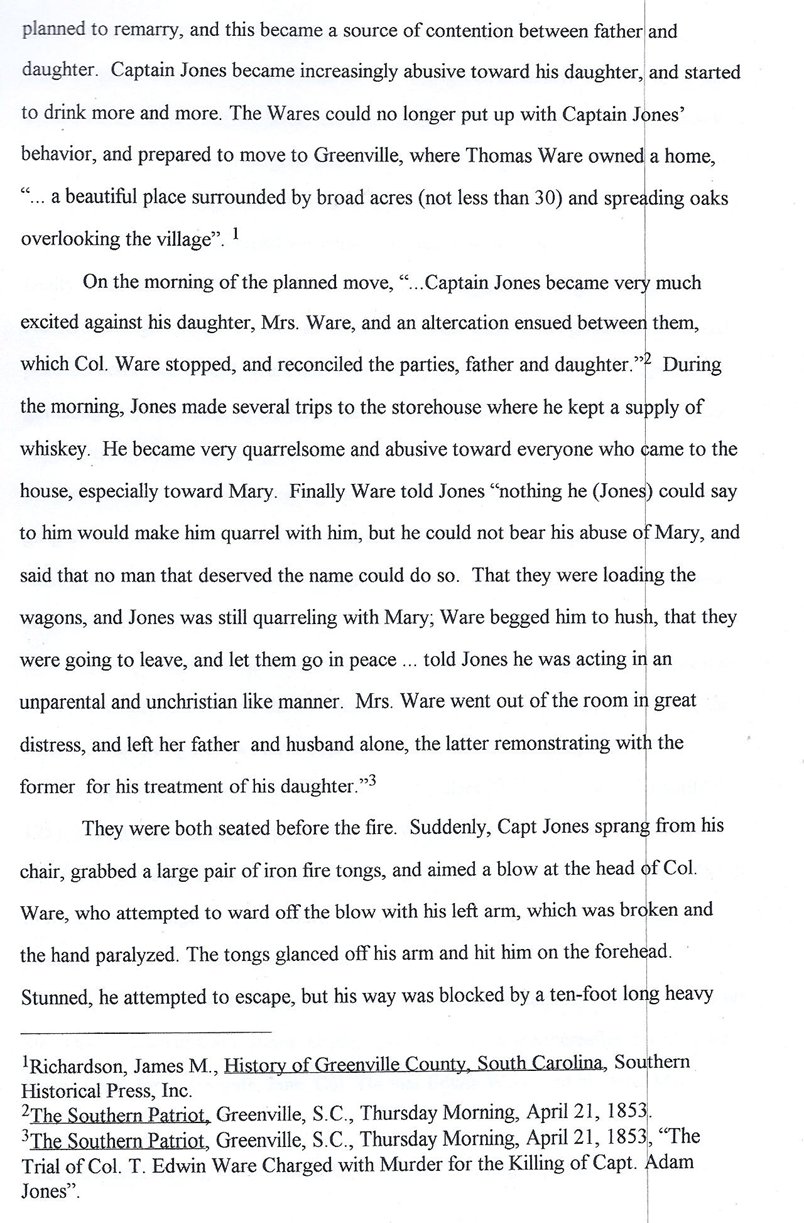
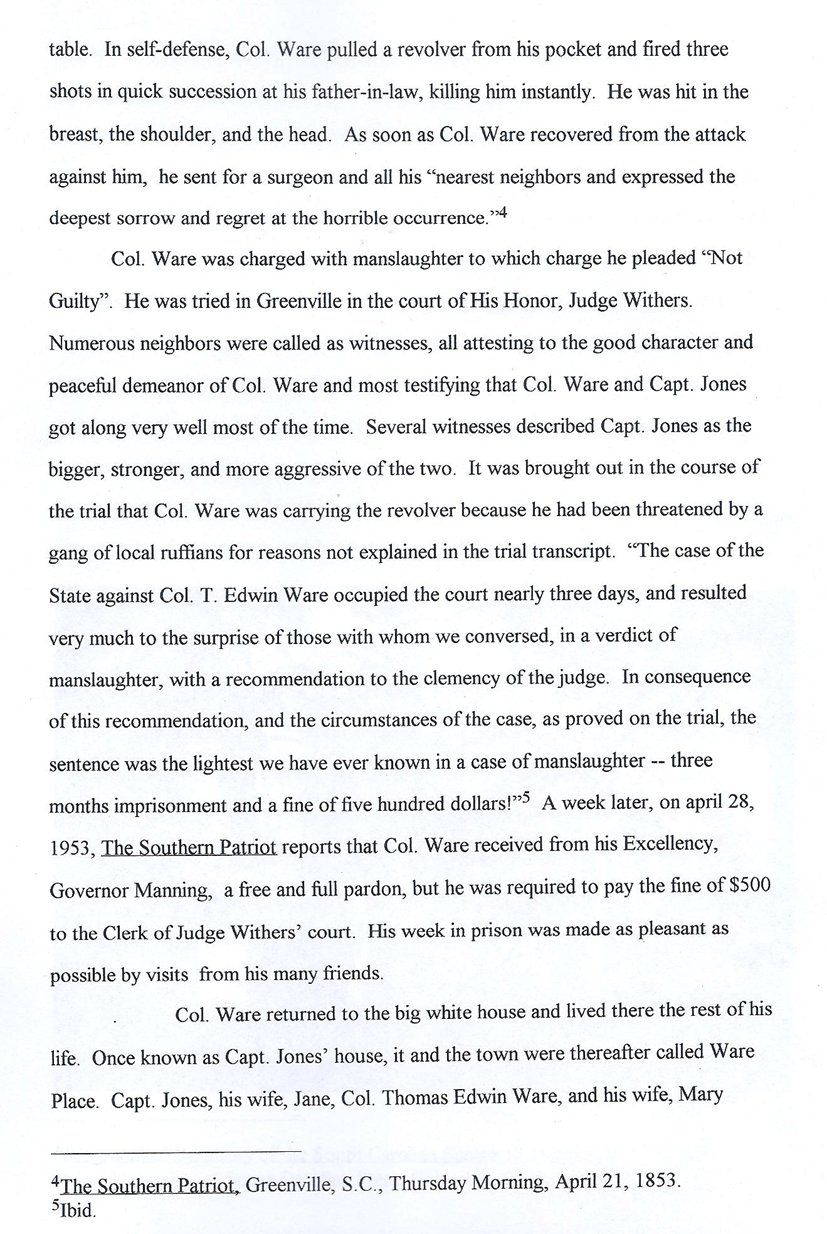
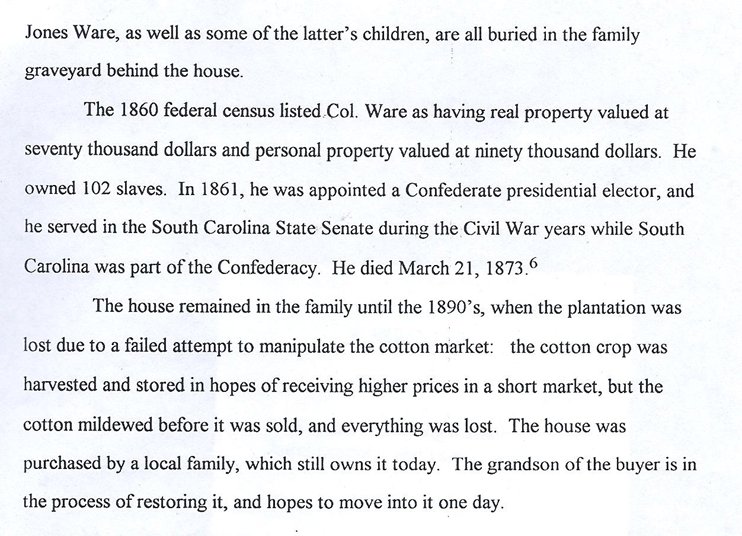
Below is the announcement of the pardon for Thomas Edwin Ware
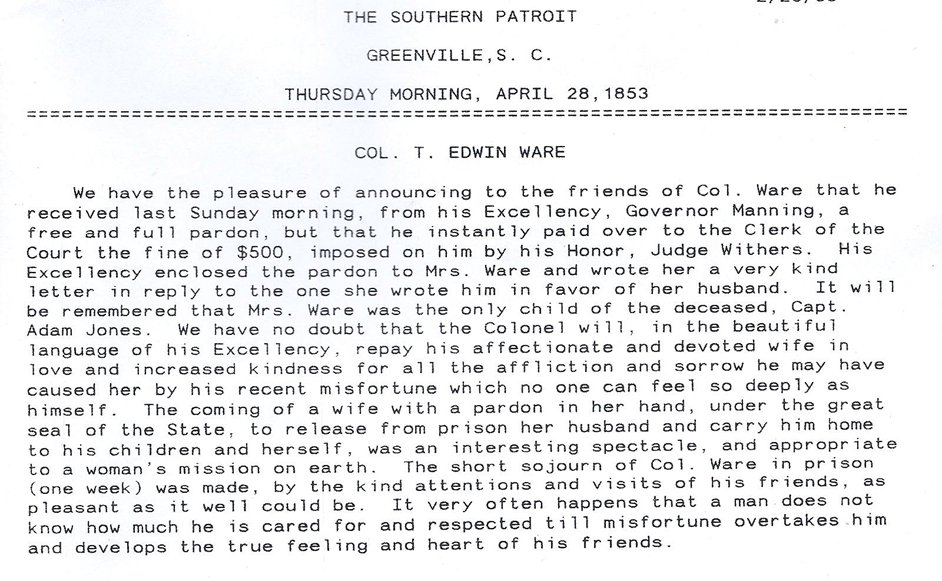
(Ref. 2556)
Thomas and Mary continued to live at Ware
Place for the next 20 years. It was
here that they had started their family and raised their children - the
grandchildren of
Edmund and Margaret and great grandchildren of
Nicholas
and Peggy. The nine children were:
Mary Pauline,
James Edwin, Anna
Louisa, Margaret Jane,
Edmund James,
Albert Williams, Thomas Jr.,
Clarence Eugene,
Mary, and George Barstow.
1. Mary Pauline Ware
(born March 25, 1836) wed James H. Arnold on April 22, 1858,
at her parent’s home, Ware Place.
She was called Pauline as can be seen in the following news clipping.
Marriage and Death Notices From the Up-Country of South Carolina as taken from
Greenville newspapers 1826 - 1863
compiled by Brent H. Holcomb
Married on
Thursday evening, the 22nd ult., by Rev. Mr. Wells, Mr. James H. Arnold of
Laurens District, to Miss Pauline Ware, of this district. (May 6, 1858)
2. James Edwin Ware
(February 15, 1838)
He died on December 1, 1854, at the age of 16.
3. Anna Louisa Ware
(January 29, 1840) married Major Garland Mitchell Ryals
on October 25, 1870. Major Ryals was
Provost Marshal to General J. E. B. Stuart during the Civil War. Below is an oil painting done by Ron Lesser in 2003, titled
The Shelling of Carlisle -- July 1-2. Major (then Lieutenant) Garland Ryals
(husband of
Anna Louisa Ware) is one of the soldiers depicted in the painting.
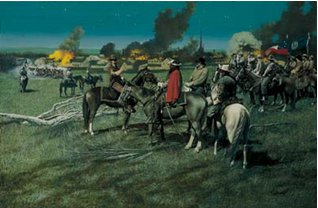
In foreground, left to right, Major Andrew Reid Venable, Major General Jeb Stuart, Lt.
Garland Mitchell Ryals, Major Talcott
Eliason
![[graphic]](http://www.waregenealogy.com/Images/NNNH157.jpg)
Garland Mitchell Ryals
Garland married
Anna Ware on October 21, 1870, and they
had four children. Garland died in
1904 from complications due to diabetes.
Anna Ware Ryals died May 17, 1912.
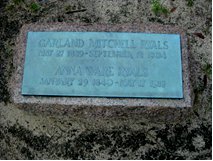
Grave marker for Garland Mitchell Ryals and
Anna Louisa
Ware Ryals
4. Margaret Jane Ware
(May 3, 1842) was born at Ware Place (as all the younger
children were). She only lived six
years, dying in December 1848.
5. Edmund
James Ware (December 19, 1845) In June 1864, he was mortally wounded
in Virginia during a battle. His
body was brought home and interned at the old place.
6. Albert Williams Ware
(September 29, 1847) Albert
wed Anna Lucy Watson on December 21, 1870, in an Episcopal church in Greenville. The couple had nine children: (1) Lucille, (2) Ethal, (3) William,
(4) Irvin, (5) Alicia, (6) Minna, (7) Mitchell, (8) Hext, and (9) Edwin. Albert died March 31, 1916.
7. Thomas E.
Ware Jr.
(August
20, 1849) married Lucy H. Foote in 1870, and they had eight children: (1)
Edwin, (2) Eugene, (3) Oliver, (4) Mary, (5) James, (6)
Ellen, (7) Simpson and (8) Charles.
Thomas Jr.
took over management of Ware Place when his parents died, and he was the last
member of the family to live there before it sold.
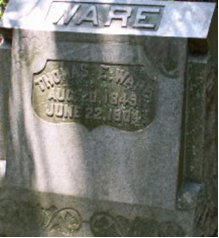
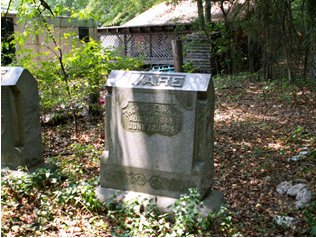
Thomas E. "Salt" Ware (1849-1904) –
son of Thomas and Mary
Both
Thomas Ware
Jr. and his wife, Lucy Foote Ware, are buried in the family cemetery
on Ware Place, along with other members of the family. The three small gravestones at the
bottom of this page are for some of their children who, clearly, died young.
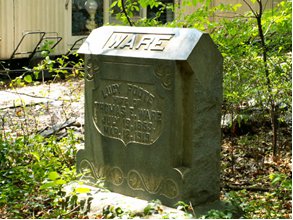
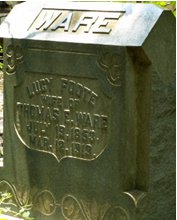
Lucy Foote Ware – wife of Thomas (Salt) E. Ware
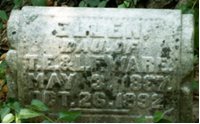
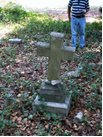
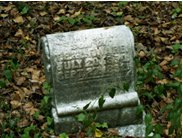
Ellen
Ware died at age 5; James Sidney Ware died
at age 3; Simpson Ware died at age 2
8. Clarence
Eugene Ware
(January
27, 1851) had the unusual nickname of “Coon” Ware. He married Mary Elizabeth Davis, and
they had the following children: John,
Martha, James, Mary, Anna, and Clarence Jr. Clarence
died August 7, 1917.
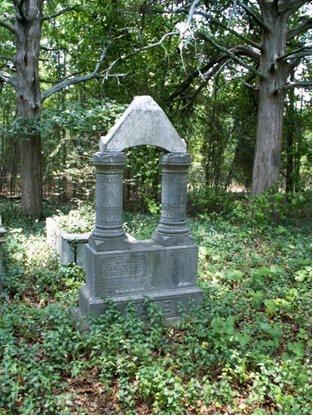
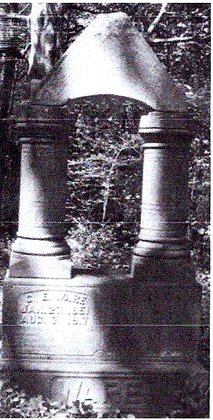
Grave for
Clarence Eugene "Coon" Ware (1851-1917)
Son of Thomas and Mary Jones Ware
9. Mary Ware
(November 26, 1854) wed William Lee Coleman, Jr., on January 10, 1877, and they
had the following five children:
Marie, William, Lewis, Edith, and Garland.
Mary died on June 28, 1920.
10. George
Barstow Ware
(March 1,
1859) He was the last child
for Thomas Edwin Ware Sr. and Mary.
Thomas Sr. and Mary put the past behind
them after the death of Adam Jones.
With the exception of their last two children, all the other offspring were born
prior to the shooting. Only baby
Mary and George would have grown up in a house without feeling the tensions that
existed between Mary and her belligerent father.
Thomas accrued great wealth in his lifetime and stayed very active in
politics.
(Ref. 2555)
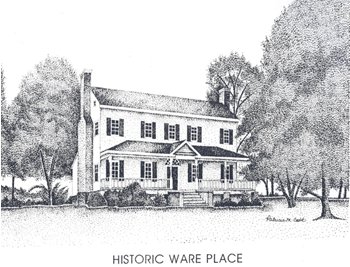

There is a graveyard on Ware Place, and one ancestor wrote
that Thomas “and his wife (Mary Catherine Jones) are buried at the
site of the Ware old home place along with several family members. The Ware
Family Cemetery is very run down and many of the graves been vandalized . . . .
This graveyard is in the woods and unkept!”
(Ref. Web)
Thankfully, there has been an effort in
recent years to restore and take better care of this historic spot. Thomas died in 1873, and Mary died in
1885.
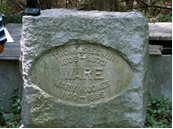
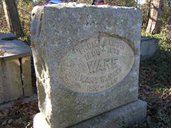
Marker for Thomas Edwin Ware Sr. 1808
-1873 and Mary W. Jones Ware 1810 -1885
Edmund and Margaret Ware prospered on their Saluda River property. The following two documents give a
good indication of how this son of Nicholas
and Peggy obviously stayed active in South Carolina civic affairs.
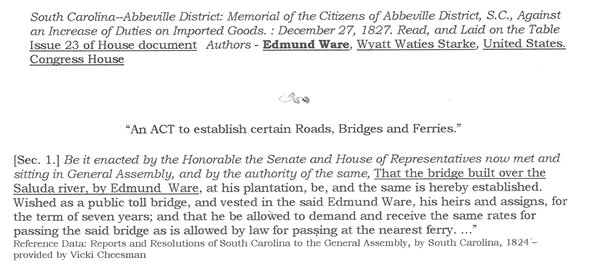
Edmund had earned the rank of major general during his military service in
South Carolina. At one point, he was
the commander of the 1st Division of the South Carolina Militia. Information
attached to The Mills Atlas Map made in 1820, for Abbeville District, refers to "General
Ware's Mill" on Saluda River, and Wanda
DeGidio validates his rank in her writing “General Ware was buried in Turkey Creek
Cemetery.”
(Ref. 379) His marker is no longer visible in the cemetery, but the church documents let us know that he “died on April 13, 1833, aged 53 years.” Margaret only lived one year
longer and her tombstone reads:
“Margaret Peggy Gaines Ware: death March 25, 1834 age 46 - wife of
Edmund.”

1833 Newspaper
Last Will & Testament for
General Edmund Ware

In 1814, Nathaniel
married Sarah Percy Ellis, the widow of Judge John
Ellis who died in 1808. Sarah had
two children (Thomas and Mary Jane) by her first marriage. She was from a prominent Southern
family, known for great affluence and social connections. Sadly, however, they were to be
remembered for another reason as well.
Several family members “had
a vulnerability to mental illness” . . . a fact which would haunt Nathaniel
for the rest of his marriage.
Sarah was “very young when left a widow by Colonel Ellis,” and Nathaniel was not only handsome, but a “man of profound learning and well versed
in science, particularly in Botany.”
He also was “a man full of eccentricities and naturally very shy and reserved in character . . . a
philosopher of the school of Voltaire, a fine scholar, with a pungent, acrid
wit, and cool sarcasm, which made him both feared and respected by those brought
into collision with him.”
(Ref. 2552)
Nathaniel had attained the rank of major
while serving as a military aide to the governor in 1812, and had
“gained appointment to the Governor’s
Legislative Council, by order of President Madison.”(Ref.
2554)
He was a man with high ambitions for the
future and was “on the way to the top.”
(Ref. 2554)
Their future looked very bright.
In addition to Sarah’s two children by her first marriage, another baby joined
the household in Natchez, Mississippi, on
June 6, 1816. Nathaniel and
Sarah named their first daughter Catherine Ann Ware. The little girl would later be described as having “the Percy eye - dark gray with black lashes and a forceful
chin.”
(Ref. 2545)

Catherine Ann Ware
As she grew older, she “stood very erect”
at five foot, three inches and “had hair
black like her mother Sarah’s and half sister.”
(Ref. 2545)
Author Ida Raymond described her as having
“soft dark-gray eyes, radiating emanations
from a spirit so warm and so strong – eyes so full of vitality, both mental and
sensuous.”
(Ref. 2552)
Raymond gave an even more in-depth
description later: “Her eyes are . . . shadowed by black lashes, her brow is beautiful; nose, straight, fine and
delicate . . . her appearance is striking and attractive; genius is stamped in
every lineament.”
(Ref. 2552)
Three years after Catherine’s birth, in
1819, Nathaniel and Sarah had their last child, Eleanor Percy Ware. Eleanor was described as “a beautiful child” with a “brilliant complexion . . .
a picture to see; her eyes were as blue as
heaven, her features statuesque, her hair black.”
(Ref. 2552)
Where Catharine was thought to be “shy and sensitive,” Eleanor was
“self-reliant, gay; dancing like a
sunbeam.” (Ref. 2552)
The siblings were incredibly close, and as Raymond wrote, “the love between these sisters was peculiar and beautiful . . . they absolutely seemed to have
but one soul. . . . Nothing could be
more perfect than the confidence and friendship between them.”
(Ref. 2552)
A large reason for the closeness between
the two girls was probably due to the sadness they shared throughout their
childhood. Tragically, their mother,
who “was 39 when Eleanor was born and
suffered from post-partum depression following the birth . . . never fully recovered.”
(Ref. 2552)
The mental problems that dominated Sarah were a family legacy. The father whom she adored, Charles
Percy, “was a man of cultivation, taste,
and refinement, but of a melancholy nature, which, after the death of his third
son, Charles, settled into the gloom of mania.”
(Ref. 2552)
There seemed to be nothing Charles could do
to alleviate his depression so, sadly, he resorted to suicide. Sarah was only 10 years old when her
beloved parent tied a large iron kettle around his neck “and plunged to his death in the black waters of Buffalo Creek, thereafter called Percy Creek.”
(Ref. 2558)
With eerie similarity, Sarah Percy Ware’s
descent into mental illness was equally steady and unrelenting.
As young children, one can only imagine the trauma both Percy sisters endured
while watching their mother suffer.
It was said that when they went to visit her, “she never was able to recognize them. Mrs. Ware retained her health, and
some remains of former beauty. Her
hair, though snow-white, still swept almost to the floor as she stood erect, her
hands and arms were models for a sculptor; she noticed very little, sometimes
would open a book but never read any. . . . She
never recognized her husband, and he rarely ever saw her. . . .
She would weep sometimes for her baby
‘Ellen’ but would repulse the caresses of her weeping daughter, who would often
try to make her mother understand who she was.
These attempts however only distressed the poor lady.”
(Ref. 2552)
Mental illness was greatly misunderstood at this time in history, and it must
have been painful for their father to try and explain to his daughters the
reason why their mother “liked to paint or
draw flowers and birds on the walls, yet she would never use pen or brush on
canvas or sketching pad.”
(Ref. 2558)
Nathaniel, who “had once entertained hopes for a grand political future,” came to realize that those dreams
were now unattainable.
(Ref. 2558)
He
was at a loss as how to deal with Sarah’s condition. A man not prone to lavish displays of
affection or frivolous conversation under the best of circumstances, some people
saw his reserved personality as possibly contributing to Sarah’s state of mind. Others saw him as an incredibly
supportive husband and
loving father. The following is how
one author in the 1800s summed up Sarah’s situation:
With Sarah, “the family proclivity inherited from her father
declared itself, and the charming, attractive young woman never recovered her
reason. . . . Major and Mrs. Ware
were then living near Natchez. There
was the loudest expression of
sympathy and regret on the part of her many friends, by whom Mrs. Ware was
greatly beloved, but after trying every medical suggestion that the South could
afford, Major Ware was compelled to take his suffering wife to Philadelphia for
better advice - her two children by her first marriage were already there. . . . Now the father had to take charge of
his two helpless little girls, so sadly deprived of their mother's tender care. He was passionately devoted to his
little daughters, never content to have them away from him; and he did the best
he could for them. They had wealth and friends, but it was lonely for the little
things, wandering about from place to place, as their father's wretchedness led
him to do, in his restless, weary life . . . .
[They were] never long
separated from the stern, peculiar
scholar, whom they could not comprehend, except in his intense tenderness and
earnest anxiety to bring them up as lovely, refined ladies should be educated.”
(Ref. 2552)
Sarah Ware “remained in the hands of physicians in Philadelphia for eleven years.”
(Ref. 2554) Nathaniel spared no expense in trying
to get her help because records show
“she
was the highest-paying patient, and the only one accompanied by a resident slave, at
the Pennsylvania Hospital, then one of the few institutions that clinically
treated the mentally ill.”
(Ref. 2552) It did not lessen the emotional
toll on the children, however.
Nathaniel
found himself in the difficult role of a single parent. Knowing how important education was
to himself when growing up, it is not surprising that he wanted both his
daughters to have the best opportunities for learning that he could offer them. The girls
“attended the
academy of Mme. Aimée Sigoigne, an émigré from Haiti.
Her French-speaking school attracted many upper-class Southerners and
Philadelphians.” (Ref. 2552)
In addition,
Nathaniel, who used travel as a way to deal with his own sense of loss and
sadness, “frequently took his young
daughters with him.”
(Ref. 2552)
In an interesting work, titled Prince
Among Slaves, and produced by the Cultural Legacy of Enslaved Africans, we
find a little known side of Nathaniel’s character. The following is an excerpt from this
article found on the web:
“In April, 1828, as Abdul Rahman boarded the steamship Neptune and watched Natchez fade into the
distance for the last time, it was surely a bittersweet parting. His own freedom in hand, Abdul Rahman
carried with him the heavy knowledge that his children's tether had not been
cut. He was accompanied on his
journey by one of Foster’s wealthy planter friends,
Nathaniel A. Ware. One of the luminaries of the colonial
South, Nathaniel A. Ware was a public official in Natchez and one-time acting
governor of Mississippi. As the father of
poets Catherine Ann Warfield and Eleanor Percy Lee, he headed what was to become
a Southern literary dynasty. [. . . . ]But as Ware accompanied the freed slave on his
journey from the land of his servitude in 1828, the Confederacy, secession, and
the unstoppable tide of abolition had not yet appeared on history's stage.
On this day, Ware was an official of the
status quo who stayed by Abdul Rahman's side until the two arrived in Washington
D.C. Here in the seat of the government
which had helped secure his release, the Prince parted company with Ware, who
went on to Philadelphia. Months later, as Abdul Rahman passed through
Philadelphia on his northern tour, the two met again.
Perhaps it was the time Ware spent in the
city where the Declaration of Independence, proclaiming the equality of all men,
had been heralded by the Liberty Bell, or perhaps it was the time he spent with
Abdul Rahman, but Ware stepped outside his expected role.
A slave owner himself, he donated $10
(which in those days was real money) to the fund to free Abdul Rahman's
children.”
Nathaniel was clearly an enigma: a
Southerner with a sympathetic heart- - a devoted husband who developed a
withdrawn demeanor - - and a father who was loving, yet often aloof.
Both daughters showed great literary aptitude at an early age. Eleanor wrote her first poem at the
age of 11, and Catherine Ann was soon creating her own verses. Their writing was often moody and
dark, however; probably reflecting their sadness over their mother. Nathaniel encouraged them greatly in
their endeavors, even going so far as to commission publishers for them.
In 1831, Nathaniel “moved Sarah back to Natchez, where she was under the care of her son Thomas George Ellis, from
her first marriage.
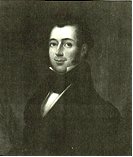
Thomas George Percy Ellis
Catherine
Anne and Eleanor would visit their mother every summer when home from school.”
(Ref. 2552)
Even though she was among family,
Sarah did not rally. One of Thomas’ daughters, Sarah Percy
Ellis, recalled her grandmother as “hopelessly
melancholy, possessing everything that the prestige of birth, and rank, and
wealth could give; but the ‘skeleton in the closet’ was always there, and for
years this dreadful thought pursued her.”
(Ref. 2552)
The whole family was well aware of the
inclination for mental instability, and it must have brought terrifying
questions. Thomas’ sister, Mary
Jane, had also “for long years suffered .
. . under eclipses of reason” and her
“slip into insanity in 1838” was another blow to a family besieged by grief.
(Ref. 2554)
In his own way of dealing with the situation, Nathaniel made it clear that
Sarah’s condition was not to be talked about or discussed – a common reaction
for the times in which he lived, but also an isolating factor for his confused
and suffering children.
Both Eleanor and Catherine found an outlet for their emotions by “translating gloom of mind into poetry and fiction.”
(Ref. 2554) They hated the times when their
father had to travel alone and felt abandoned when he left. Even though he was not a
demonstrative man, they adored him and craved his attention and affection. In 1836, their mother, Sarah Percy
Ellis Ware, died at the age of 56 - finally achieving the peace that alluded her
most of her life. Thus would end
Nathaniel’s 22 years of wedlock. Not
surprisingly, he never chose to remarry.
By the time of Sarah’s death, Catherine had
been married for three years. “At age sixteen, on
January 3, 1833, Catherine Ann wedded Robert Elisha Warfield, a son of the prominent Lexington,
Kentucky physician and Thoroughbred breeder . . .
the Warfield family had founded the
Lexington Association Race Course.”
(Ref. 2554)
The couple settled in Kentucky.
Marriage Notes for Robert Elisha Warfield and Katherine/Catherine Ann
Percy Ware:
Record of a marriage of Elisha Warfield,Jr., of
Lexington, KY, to Miss Catherine Ann Ware of Philadelphia. Married in
Cincinnati, OH, 28 Jan 1833
Nathaniel’s youngest daughter, Eleanor,
waited until she was older before marriage.
On May 25, 1840, she wed the cousin of Robert E. Lee, William Henry Lee.
“Her father settled the couple with a large dowry from
Eleanor's mother's legacy: ‘a large
plantation in Hinds County, Mississippi, with about 85 slaves, assessed in 1838
at the value of $122,000.’"
(Ref. 2554)
Their beautiful estate was called
‘Ditchely,’ and although Eleanor died earlier, William Henry Lee resided there
until his own death in 1874.
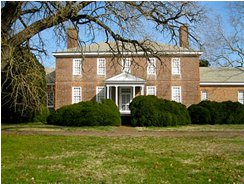
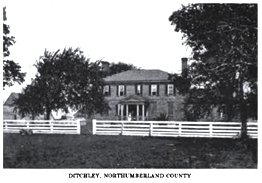
Ditchley
Throughout their lives, the two sisters
shared their common love of writing.
They were both competitive and supportive. “Ellen had the gift of total recall and
could recite without error any poem that she fancied. Catherine, however, had greater
sensitivity and inventiveness than her sister, but they liked to think that
their talents complemented each other’s.”
(Ref. 2554)
Nathaniel was, with good reason, very proud of both of them, and the girls were
“gratified that their father thought their
work publishable.”
(Ref. 2554)
It would seem that both literary talent and tragic mental illness would continue
to afflict the family, however. “After their mother's death, the sisters
next suffered the death in 1844 of their half-sister Mary Jane Ellis LaRoche
(who appeared to have suffered from post-partum depression and lingering mental
illness for several years) and later their half-brother Thomas Ellis” as
well.
(Ref. Wikipedia)
Thomas died at the young age of 33.
Although not as severe, Eleanor seemed to
have inherited the family predisposition for depression. After the loss of Mary Jane and
Thomas, her zest for life declined. “Of the two sisters, Catherine was the more accomplished and much more prolific poet.”
(Ref. 2554)
In fact, sometime earlier, Eleanor “gave
Catherine the editing lead for their joint volumes. . . . In the summer of 1849, while at the
resort of Mississippi Springs, she complained of melancholy [our word for
depression].
She died of yellow fever during an
epidemic that summer, at the age of 30.”
(Ref. 2554) Eleanor
had only been married nine years.
Nathaniel’s oldest daughter, Catherine,
appears not to have been as emotionally fragile as her other family members,
although even Catherine had a bad bout of depression. “After Eleanor died of yellow fever in 1849, Warfield ceased writing for several years, as she
was stricken with melancholy.”
(Ref. Wikipedia)
She was able to overcome her natural grief, however. In “the mid-1850s, Catherine was encouraged
to start writing again by her niece Sarah Ellis, already a successful novelist. In 1860 Warfield published
anonymously as ‘A Southern Lady’ [a book titled]
The Household of Bouverie, a
gothic fiction in two volumes. It
achieved great popular success. . . .
After the Civil War, Warfield published eight more novels, all under her
own name. The two most popular were
Ferne Fleming (1877) and its
sequel The Cardinal’s Daughter
(1877).” (Ref.
2552)
On the home front, Catherine and Robert were busy raising their six children in
Kentucky. It is hard to know how
much satisfaction Catherine gained from her writing success since “remembering a cheerless childhood under
the supervision of austere governesses and a distant father and, above all,
denied a mother’s love, Catherine early had learned to hide her feelings.”
(Ref. 2558) It would seem, however, that
she gained great comfort from her Catholic religion because she
“recognized that order, structure, hierarchy, and a moral imperative could challenge depression.”
(Ref. 2554) Her faith gave her hope and a way to
reconcile loss and pain. The
following are some of her books that were published (The Household of
Bouverie probably her most famous).
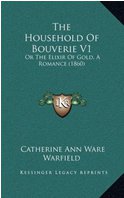
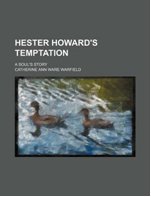
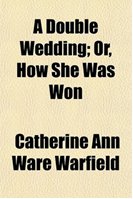

Catherine Ware Warfield died in 1877 and is buried in Kentucky.
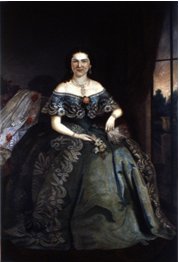
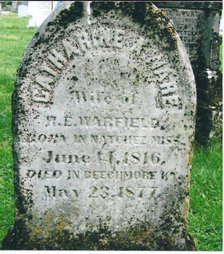
Catherine Ann Ware Warfield
Sarah Anne Ellis, cousin to Eleanor and Catherine, would also become well known
for her literary accomplishments.
Her style leaned more toward historical writing, however, and she did not shy
away from political issues. After
her husband (Samuel Dorsey) died, Sarah invited Mr. and Mrs. Jefferson Davis to
her home called ‘Beauvoir’ in Biloxi, Mississippi. The former president of the
Confederacy was struggling in his efforts to write his memoirs. With no children or husband to tend
to, Sarah devoted herself to helping Davis with his autobiography.
“She transcribed notes, took dictation, corrected prose, and offered
advice about style and organization.”
(Ref. 2554)
When she realized, in the winter of 1877,
that she was dying of breast cancer, Sarah changed her will, making
“her sole commitment to Jefferson Davis’s
ease in retirement.”
(Ref. 2554)
As “the only heir of her fortune,” he now became the
owner of her beautiful waterfront property of Beauvoir.
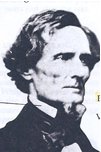
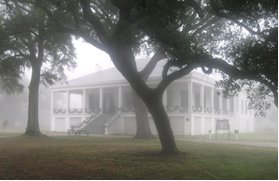
Jefferson Davis
;
Beauvoir
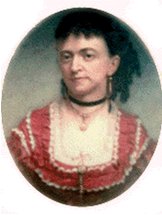
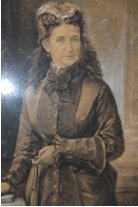
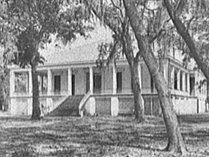
Sarah
Ellis Percy Dorsey;
Beauvoir 1901
Photo
courtesy Library of Congress Prints and Photographs Division
Major
Nathaniel Ware lived to see some of his oldest daughter’s works
published, but he died before Catherine really reached her full height of fame. Ever traveling, he had made several land investments during his
lifetime - - one near Galveston, Texas.
It was there that he died in 1856 of yellow fever. Catherine erected a monument for him
in Kentucky to honor his life.
Following photos taken by James and Judy Ware 2012
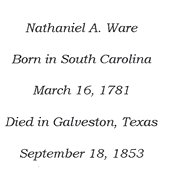
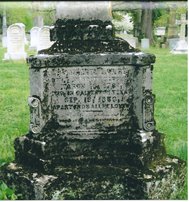
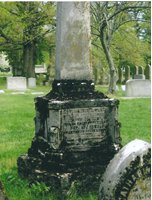
The inscription reads:
My
Father - We shall meet again
“Because thy loving kindness was better to me than life, my
lips shall praise thee.
Because
thou hast been my help, therefore in the shadow of thy wings will I rejoice”
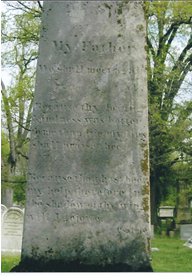
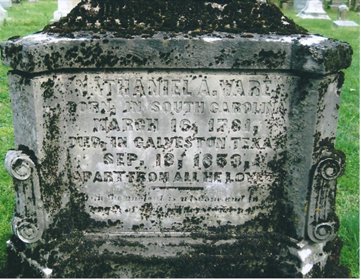
There
is more writing at the very bottom of the stone but it is too difficult to make
out at this time.
With the birth of
Nathaniel Ware,
Nicholas
and Peggy Hodges Ware had completed their family.
They were now able to chart their own course in making a mark on this now
‘united’ nation. For several
reasons, Nicholas decided to relocate his family to South Carolina.
During the 1700s most of South Carolina was occupied by the Cherokee Indians.
Understandably, these natives were not overly thrilled with the constant press
of white settlers encroaching on their lands.
There was not only conflict with the colonists but between different
Indian tribes as well. In 1758, when
Nicholas was 19 years old, Cherokee “warriors
accompanied Virginian troops on a campaign against the Shawnee of the Ohio
Country. During the expedition, the
[Shawnee] enemy proved elusive, while
. . . the Cherokee stayed, but dwindled.”
(Ref. Wikipedia) It is very possible, because of his
age, that Nicholas was part of this Virginia military unit sent to the area.
It was not long before the Virginians and the Cherokee turned on each other and
began fighting. The situation would
become quite grim.
The following
excerpt was taken from a work called “The Scotch-Irish, and their First
Settlements on the Tyger River, and Other Neighboring Precincts in South
Carolina, a Centennial Discourse” which was delivered at Nazareth Church,
Spartanburg District, South Carolina on September 14, 1861, by George Howe.
“But now came a season of dreadful trial to
these devoted people. The Indian tribes,
which almost surrounded them, became incensed against the whites, and rose in
arms to destroy them. The inhabitants of
Long Canes, in Abbeville, fled for refuge to the older and more settled parts of
the country. A party, of whom Patrick
Calhoun was one, who were removing their wives and children and more valuable
effects to Augusta, were attacked by the Cherokees, on February 1st, 1760, and,
according to contemporary journals, some fifty persons . . . (mostly women and
children)
were slain, and fourteen carried into
captivity. After the massacre, many children were found wandering in the woods.
One man brought fourteen of these young fugitives into Augusta, some of whom had been cut with
tomahawks and left for dead. Others were
found on the bloody field, scalped, but living still. Patrick Calhoun, who returned to the
spot to bury the dead, found twenty dead bodies, inhumanly mangled. The Indians
had set fire to the woods, and had rifled the carts and wagons, thirteen in
number.”
This Indian attack became known as “Long
Canes Massacre,” and “it awoke the
indignation of the colonial government towards the Indians and resulted in the
burning of Cherokee towns. Patrick
Calhoun returned to the massacre site in 1760 and erected two stone markers,
which are still standing today.”
(Ref. Wikipedia)
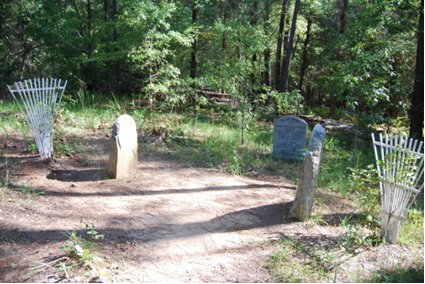
Site of the mass grave for the victims of the Long Cane Massacre
This attack on the colonists invoked massive retaliations from
the military. In 1761, after much
fighting, the Cherokees sued for peace and agreed to cede most of their lands in
South Carolina. The “Bounty Act” of
1761
provided cash money to anyone who brought settlers into the colony of South
Carolina, thereby serving as a deterrent against future Indian attacks in the
area. By 1777, the peace had forced
“a cession by the Cherokee of over
5,000,000 acres of land.”
(Ref. Wikipedia)
Even if
Nicholas was not part of these specific militia
engagements with the Indians, he certainly would have benefited from this land
when the Revolutionary War ended.
“The Bounty Act of 1761 offered public
land tax free for ten years, and settlers from other colonies began pouring into
the up country.”(Wikipedia)
With this “land lottery established for any white
man, following the removal of all Indians in this area,” Nicholas could
offset the problems he faced with a culture that still adhered to the
primogeniture custom.
(Primogeniture is the right, by law
or custom, of the firstborn to inherit the bulk of the estate, to the exclusion
of younger siblings.) Since
he was
a second born son, Nicholas’ best chances of large land
ownership clearly would lay outside the boundaries of Virginia.
There were actually other Ware families that moved to this part of the country
as well. According to Hayden’s
genealogy book,
“Henry Ware arrived in the Piedmont area
of South Carolina sometime shortly after 1771, with his wife's parents John
Garrett and Frances Dudley. His brother Col. Nicholas and wife Dolly Garrett
followed on 2 Oct 1782, the date he received his first land grant on Steven's
Creek.
Soon other Wares began to arrive in Edgefield,
Capt. Robert Ware (spouse of Margaret Tankersley, and son of Nicholas Ware and
Sarah Munday); James Ware (spouse of Mary "Molly" Veal); Edward Ware (spouse of
Sarah Thurmond), (these last two were sons of Edward Ware and Lettice Powell);
and Nicholas of
Abbeville (spouse of Peggy Hodges), son of James and Agnes
Todd. All six became known as those "Six
Ware Pioneers" in the Carolina - Georgia section
(Ref. 6)
It was the cousin of James and Agnes’ son, known as Nicholas of Edgefield, who would later
became a Georgia Senator.
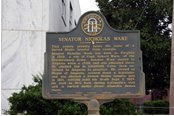
Historical marker for Senator Nicholas Ware of Georgia
James and Agnes’ son, Nicholas Ware, would, consequently, establish another
branch of the large Ware family tree in South Carolina. He and Peggy
settled near a wonderful location for mills and future industry. The name of their place came to be
called Ware’s Shoals; coming from “the
name of the owner of the nearby gristmill, Nicholas Ware. His name was combined with the
river’s shoals to create the name of Ware’s Shoals; later shortened to
Ware Shoals.”
(Ref. 819)
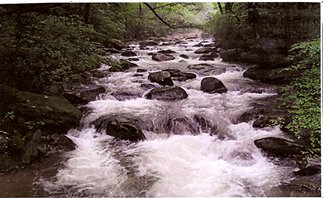
Ware
Shoals
Eventually the town of Abbeville was “built around him . . . and he was called
‘Abbeville Nicholas’ to distinguish him from a kinsman of the same name, who
settled in the Edgefield District and became known as the ‘Edgefield’ Nicholas. The Hodges Family also came from
Virginia to settle nearby where a town of Hodges, S. C. was built.”
(Ref. 32,379)
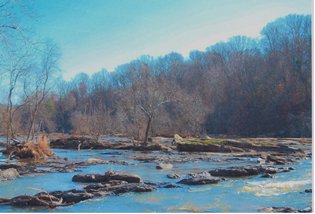
Ware Shoals
Although the following 1954 map is far more
current than the times in which Nicholas lived, it does show how close Ware
Shoals is to the Saluda River and the proximity of Abbeville, South Carolina, to
the state of Georgia.
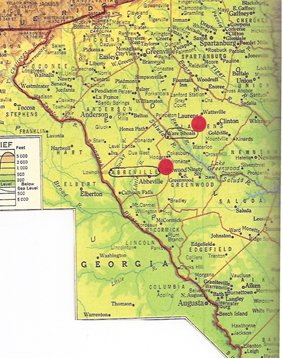
Map showing Abbeville, Ware Shoals, and Georgia border
The larger map below shows the county of
Abbeville, and on the smaller map the tiny red dot shows the location of Ware
Shoals in the Abbeville area.
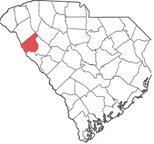 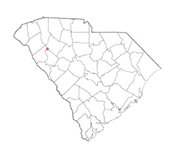
Abbeville County / Ware
Shoals
This section of South Carolina was so scenic that it became a beloved place for people to visit
“A
favorite spot for taking in the beauty of the area - picnicking, wading and
fishing, the banks of the Saluda River have drawn folks from the surrounding
countryside for more than 200 years.”
(Tourism site)
There is currently a park at Ware Shoals named Irvin Pitts Park. The historical marker there mentions
Nicholas Ware as the namesake of the area. (Ref.819) There
have been some reports which state that the owner of the nearby mill was William
Ware, Nicholas’ son, and it probably was - - eventually. William took over his father’s legacy
and, sadly, Nicholas did not live too long after his move to South Carolina.
Either way, the land and the mill began
with the dream of Nicholas.
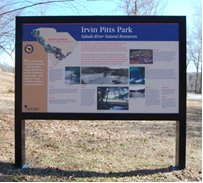
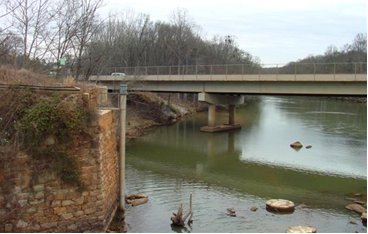
Sign
mentioning Nicholas /
The Saluda River has a bridge over it that was named
Ware Bridge
Nicholas was “reportedly a Baptist preacher during that time and Ware Shoals in present day Greenwood Co.,
S.C. is named for his descendants.”
(Ref. Dale Grissom)
In 1967, an article was written by
Mrs. Sara S. Ervin, the historian for Mt. Bethel United Methodist Church in Ware
Shoals, concerning the Ware family who helped settle the area. She wrote: “Nicholas
Ware, a patriotic preacher who did much to help American Independence . . . was
a pioneer in [mill] work in the upcountry of South Carolina.”
Nicholas had long since left the Episcopal Church and joined
the Baptist faith while back in Virginia.
He and Peggy were faithful members of the Broad Run Baptist Church which
had been founded in 1762. The
congregation was the result of a body of believers who were willing to break
with the Anglican Church, the only church recognized by law at the time. “Those
not part of the Anglican Church were considered inferior and were levied with
extraneous taxes. Baptist preachers and followers were constantly slandered by
the main religious body and were mocked by other members of the populace.
On December 3, 1762, David Thomas, one of
the Baptist preachers, tired of being ostracized by the Anglicans, and John
Marks organized and established the church Broad Run, and the following day 23
people were baptized.”
(Ref. Wikipedia)
According to
the
"Minutes of Broad Run Baptist Church, Faquier Co., Va., 1762-1872," we learn that Nicholas
was appointed to the position of ‘clerk’ in 1773.
There are several annotations in the records that refer to him with that
title.
NICHOLAS WARE APPOINTED CLERK 1773
We also learn that Nicholas and Peggy were both
“dismissed to South Carolina” so it is
very possible that the church played a large part in Nicholas’s decision to move
to Abbeville.
“1783 NICHOLAS WARE OCT 25 DISMISSED TO SOUTH/MARTHA WARE OCT 25 DISMISSED TO SOUTH CAROLINA”
The minutes
of the Broad Run Baptist Church further state that “on October the 25th of 1783 several
families . . . were dismissed to go south. These
families traveled to Abbeville County, South Carolina and the Turkey Creek
Baptist Church was organized on January the 29th in 1785.”
There are many records in South Carolina
which list Nicholas and Peggy as “charter members of the Turkey Creek Baptist Church in the Abbeville
area.” (Ref. 872B, 2548)
As one document specifically stated, this
new church was “organized on
January 29, 1785, with some of its families transferring over from Broad Run
Baptist Church.”
(Ref. 896)
A major milestone that resulted from the Revolutionary War victory was the
passing of the
Statute for Religious Freedom.
“In November 1776, the legislature
[had] approved resolutions calling for a
repeal of laws punishing the failure to attend an Anglican church, together with
a repeal of taxes to support the established church. No longer, according to the new
dispensation, would tax money pay the salaries of Anglican ministers.”
(Ref. 2539)
When Thomas Jefferson’s official document
went into effect in 1786, it provided even further religious freedoms for the
colonists, marking a true delineation between church and state. Not only could families worship as
they pleased, they were no longer taxed to support a church they did not even
attend. Having just been at war with
England, it is not surprising that the freed people wanted little to do with the
Church of England.
In a book called
From Hill to Dale to Hollow - Ware Shoals, South Carolina, put together by a town committee in 1983, we can learn more about the Ware’s transition from
Virginia to their new home:
“Other notable Prince
William County families, some already with close ties to this Smith family, also
migrated to this area of South Carolina. These
families include: Baremore . . .
Mitchell, Mattison, Nash, Northcutt, Ware, Hall, Dodson, Watkins, Foster,
and others. A number of these
families, along with the Smiths, helped to start Turkey Creek Baptist Church in
Abbeville County. On January 29,
1785, the following individuals constituted Turkey Creek Baptist Church in
Abbeville County, South Carolina (it is interesting to note that all
constituents came from Broad Run Baptist Church in Fauquier County, Virginia):
Joseph Redding, Sarah Foster . . .
Archibald Shirley, Margaret Shirley, Mary Shirley, Richard Shirley, Thomas
Shirley, James Smith, Joseph Smith, Leannah Smith, Mary Smith, Sarah Smith,
Martha Ware and Nicholas Ware.
Rev. Joseph Redding was made the pastor on May 7, 1785.”
(Underlining done by JC Ware)
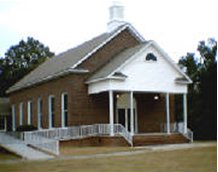
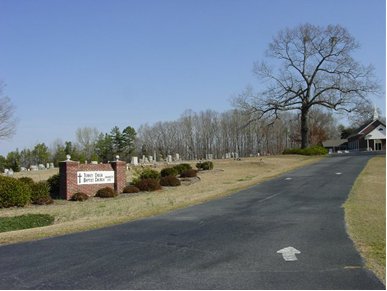
Outside of Turkey Creek Baptist Church 2009 / Entrance into Turkey Creek Baptist Church
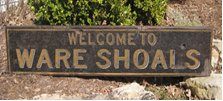
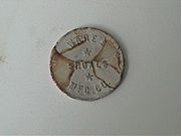
Scrip was used
as
currency in textile
mill towns,
it could only be used in the company store. /
Old sign
Nicholas
and Peggy, sadly, did not get to spend much time with their children after the
move to South Carolina. Church
records provide the death date of Nicholas as March 26, 1787, and we know from
their grandson’s biography that both Nicholas and Peggy died around the
same time. It would appear that they
knew their passing was imminent because as Nicholas Ware Hodges wrote, “they
left under my father's care their two youngest sons, Edward and Nathaniel A. Ware, at a tender
age.”
(Ref. 875)
Nicholas
would have been 48 years old and Peggy 49.
Their children must have been devastated.
Oldest daughter, Nancy, (at age 20) had just married James Hodges the
year before, and as mentioned earlier, the young couple took in Edmund (age
seven) and Nathaniel (age 6) to stay with them.
The other children were in their teens by this time.
In
the will of Nicholas Ware, dated February 7, 1787, he lists his children as
“Frances,
William,
Thomas,
James,
Betsey,
Edmond,
and Nathaniel
Ware, Nancy
wife of Jas., Geo. Waller the husband of Frances.
Extrs: William Ware, John Nash, Joseph Reden. Wit: John Hall, Archibald Shirley, C.
Matthews.” (Ref.
Will)
From the wording of this document (and the fact that we know Peggy died sometime
the same year as Nicholas), it would be safe to assume that she had passed away
in February – with Nicholas following only a few weeks later.
James and Agnes
must have felt equally saddened.
Even though they probably did not get a chance to see their grandchildren by
Nicholas and Peggy, James made sure to remember them in his own will. When he wrote his last wishes in
1790, he specifically requested his land was to
“be sold and the money equally divided
amongst all my children hereafter named viz John Ware, Nicholas Ware’s heirs,
James Ware, Clary Sale, William Ware, and Edmond Ware - them and their heirs
forever.”
(Ref. Will) It
would appear that, although other things might alter with the years, neither
time nor distance would change the affections of this grandparent.
Supporting Documentation for Chapter 5
CHILDREN OF: NICHOLAS WARE &
MARTHA (PEGGY) HODGES
B. August 12, 1739
1762
B. 1738
D. March 26, 1787
D. 1787
Nicholas was the 2nd son of James Ware and Agnes Todd Ware. He married Martha (Peggy) Hodges in
1762.
1
James
Ware (1763 – 1765)
2
Frances
Ware (1766 - ) wed George Wilder.
3
Nancy
Ware (1767 – 1856) wed
James L.
Hodges in January 1786.
4
William
Ware (1768 - Oct. 12, 1856) wed Mary
Agnew.
5
Thomas
Ware (1770 - February 28, 1853) wed
(1) Sarah Gaines and (2)
Nancy
Johnson.
6 Elizabeth
(Bettey) Ware (March 22, 1774 – 1860)
wed John Henry
Madison
on Aug. 11, 1794. Her second husband
was Benjamin Pendleton
Gaines,
and they wed on Jan. 17, 1806.
7
Edmund
Pendleton Ware (Aug. 16, 1780 -
April 13, 1833) wed Theodocia
Nash and Margaret Peggy
Gaines.
8
Nathaniel Ware (March 16,
1781 - Sept. 18, 1853) died in
Galveston.
The following is a poem written by Eleanor Percy Lee – the granddaughter of
Nicholas and Peggy Ware and the great granddaughter of James and Agnes.
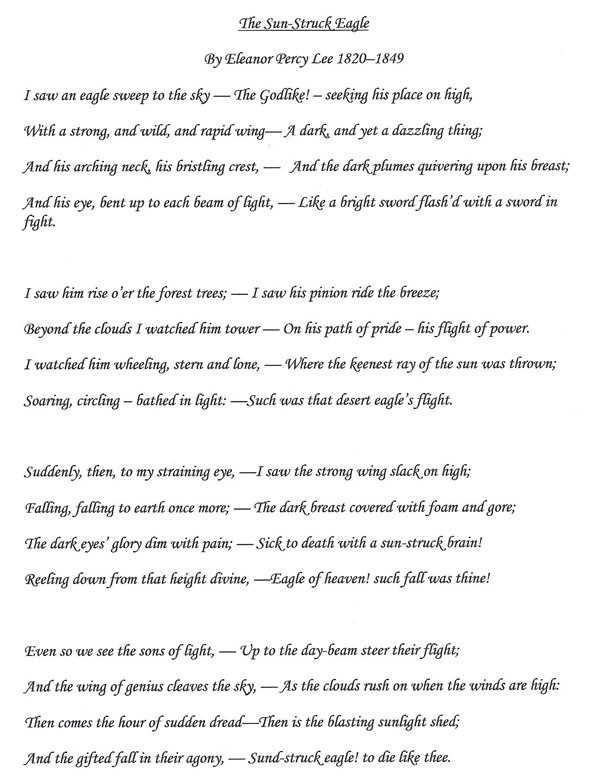
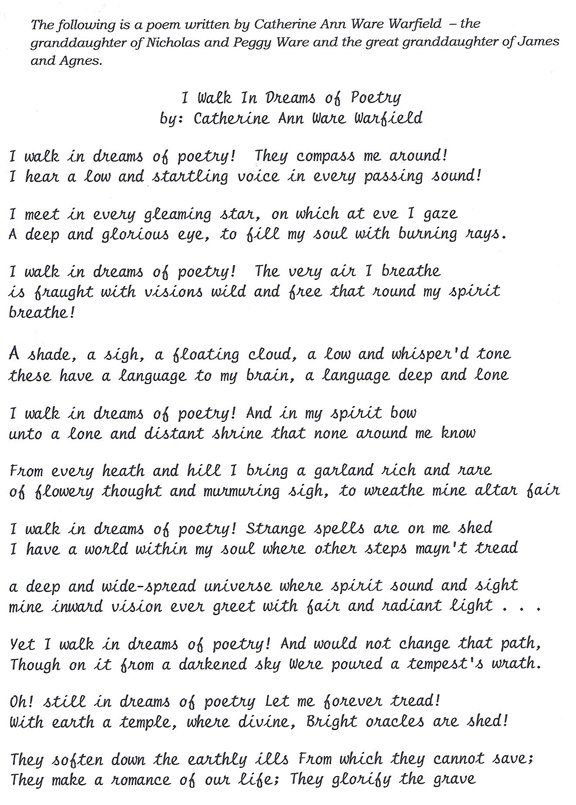
|

